u blox 2AGQN4NNN Cellular Module User Manual SARA R4 N4 series
u-blox AG Cellular Module SARA R4 N4 series
u blox >
Contents
User Manual 1
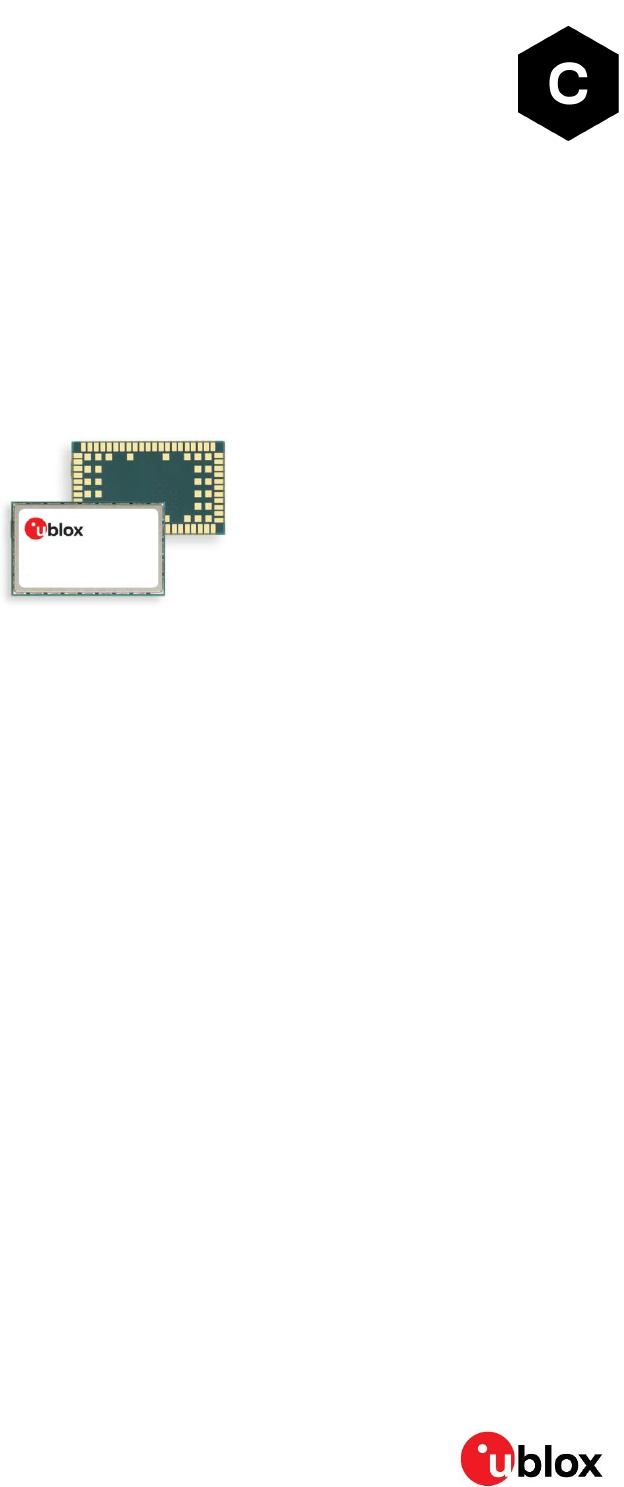
SARA-R4/N4 series
LTE Cat M1 / NB1 and EGPRS modules
Data Sheet
Abstract
Technical data sheet describing the size-optimized SARA-R4/N4 series LTE Cat M1 / NB1 and
EGPRS cellular modules. The modules are a complete and cost efficient solution offering multi
band data transmissions for Low Power Wide Area solutions in a compact form factor.
www.u-blox.com
UBX-16024152 - R11
SARA-
R4/N4
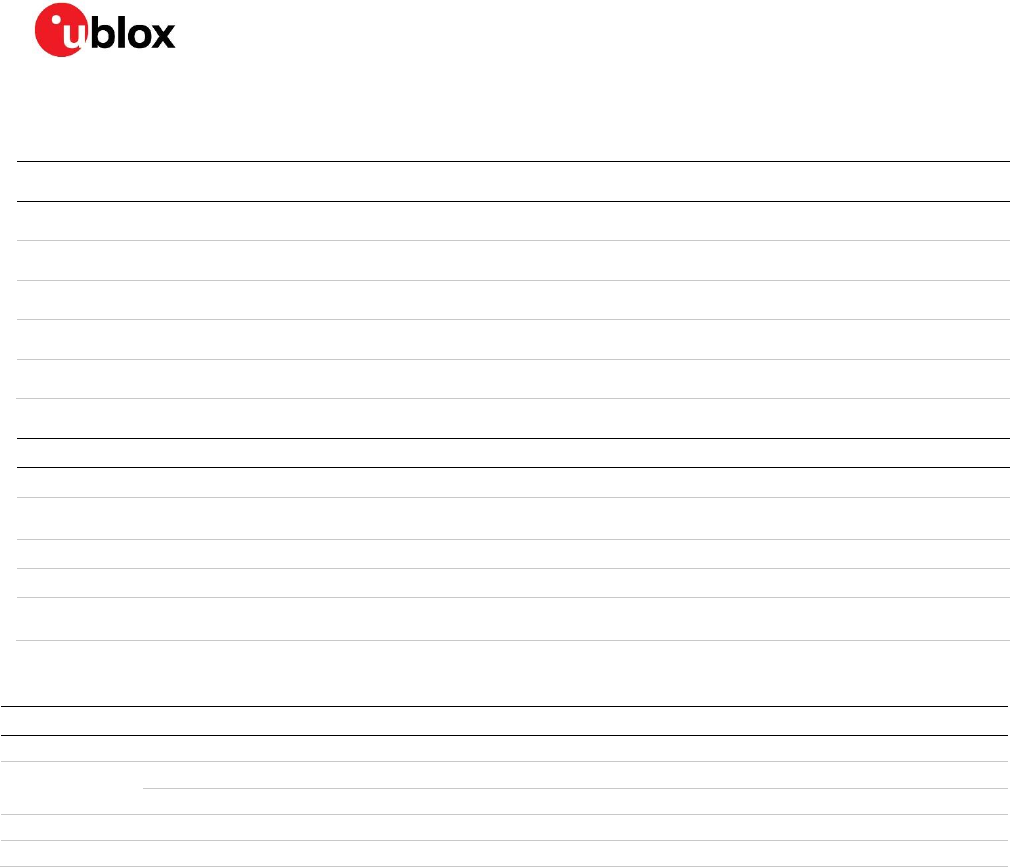
SARA-R4/N4 series - Data Sheet
UBX-16024152 - R11 Page 2 of 41
Document Information
Title
SARA-R4/N4 series
Subtitle
LTE Cat M1 / NB1 and EGPRS modules
Document type
Data Sheet
Document number
UBX-16024152
Revision and date
R11
09-May-2018
Disclosure Restriction
Product status
Corresponding content status
Functional Sample
Draft
For functional testing. Revised and supplementary data will be published later.
In Development /
Prototype
Objective Specification
Target values. Revised and supplementary data will be published later.
Engineering Sample
Advance Information
Data based on early testing. Revised and supplementary data will be published later.
Initial Production
Early Production Information
Data from product verification. Revised and supplementary data may be published later.
Mass Production /
End of Life
Production Information
Document contains the final product specification.
This document applies to the following products:
Product name
Type number
Modem version
Application version
PCN reference
Product status
SARA-R404M
SARA-R404M-00B-00
K0.0.00.00.07.06
UBX-17047084
Initial Production
SARA-R410M
SARA-R410M-01B-00
L0.0.00.00.02.03
UBX-17051617
Initial Production
SARA-R410M-02B-00
L0.0.00.00.05.06
A02.00
UBX-18010263
Initial Production
SARA-R412M
SARA-R412M-02B-00
M0.03.00
A01.03
UBX-18006467
Prototype
SARA-N410
SARA-N410-02B-00
Functional Sample
u-blox or third parties may hold intellectual property rights in the products, names, logos and designs included in this document.
Copying, reproduction, modification or disclosure to third parties of this document or any part thereof is only permitted with the
express written permission of u-blox.
The information contained herein is provided “as is” and u-blox assumes no liability for its use. No warranty, either express or
implied, is given, including but not limited to, with respect to the accuracy, correctness, reliability and fitness for a particular
purpose of the information. This document may be revised by u-blox at any time without notice. For the most recent documents,
visit www.u-blox.com.
Copyright © u-blox AG.

SARA-R4/N4 series - Data Sheet
UBX-16024152 - R11 Page 3 of 41
Contents
Document Information ................................................................................................................................ 2
Contents .......................................................................................................................................................... 3
1 Functional description ......................................................................................................................... 5
1.1 Overview ........................................................................................................................................................ 5
1.2 Product features ......................................................................................................................................... 5
1.3 Block diagram .............................................................................................................................................. 6
1.4 Product description .................................................................................................................................... 7
1.5 AT command support ................................................................................................................................ 8
1.6 Supported features .................................................................................................................................... 9
2 Interfaces ................................................................................................................................................. 9
2.1 Power management ................................................................................................................................. 10
2.1.1 Module supply input (VCC) ............................................................................................................. 10
2.1.2 Generic digital interfaces supply output (V_INT) ....................................................................... 10
2.2 Antenna interface ..................................................................................................................................... 10
2.2.1 Antenna RF interface (ANT) ........................................................................................................... 10
2.2.2 Antenna detection (ANT_DET) ...................................................................................................... 10
2.3 System functions ....................................................................................................................................... 11
2.3.1 Module power-on ............................................................................................................................... 11
2.3.2 Module power-off ............................................................................................................................... 11
2.3.3 Module reset ....................................................................................................................................... 11
2.4 SIM ................................................................................................................................................................ 11
2.4.1 SIM interface ...................................................................................................................................... 11
2.4.2 SIM detection ..................................................................................................................................... 11
2.5 Serial communication ...............................................................................................................................12
2.5.1 UART interface ...................................................................................................................................12
2.5.2 USB interface ..................................................................................................................................... 13
2.5.3 SPI interface ...................................................................................................................................... 13
2.5.4 SDIO interface ................................................................................................................................... 14
2.5.5 DDC (I2C) interface ............................................................................................................................ 14
2.6 Audio ............................................................................................................................................................ 14
2.7 GPIO ............................................................................................................................................................. 15
3 Pin definition ......................................................................................................................................... 16
3.1 Pin assignment .......................................................................................................................................... 16
4 Electrical specifications ................................................................................................................... 20
4.1 Absolute maximum rating....................................................................................................................... 20
4.1.1 Maximum ESD ................................................................................................................................... 20
4.2 Operating conditions .................................................................................................................................21
4.2.1 Operating temperature range .........................................................................................................21
4.2.2 Thermal parameters .........................................................................................................................21
4.2.3 Supply/power pins ............................................................................................................................ 22

SARA-R4/N4 series - Data Sheet
UBX-16024152 - R11 Page 4 of 41
4.2.4 Current consumption ....................................................................................................................... 23
4.2.5 LTE RF characteristics .................................................................................................................... 24
4.2.6 2G RF characteristics ...................................................................................................................... 26
4.2.7 ANT_DET pin characteristics ......................................................................................................... 26
4.2.8 PWR_ON pin ....................................................................................................................................... 27
4.2.9 RESET_N pin ...................................................................................................................................... 27
4.2.10 SIM pins .............................................................................................................................................. 27
4.2.11 USB pins ............................................................................................................................................. 28
4.2.12 Generic Digital Interfaces pins ....................................................................................................... 28
4.2.13 DDC (I2C) pins ..................................................................................................................................... 28
5 Mechanical specifications ................................................................................................................29
6 Qualification and approvals............................................................................................................. 30
6.1 Reliability tests ..........................................................................................................................................30
6.1.1 Approvals ............................................................................................................................................30
7 Product handling & soldering ........................................................................................................... 31
7.1 Packaging ................................................................................................................................................... 31
7.1.1 Reels .................................................................................................................................................... 31
7.1.2 Tapes ................................................................................................................................................... 32
7.2 Moisture Sensitivity Levels ..................................................................................................................... 33
7.3 Reflow soldering ........................................................................................................................................ 33
7.4 ESD precautions ........................................................................................................................................ 33
8 Labeling and ordering information ............................................................................................... 34
8.1 Product labeling ......................................................................................................................................... 34
8.2 Explanation of codes ................................................................................................................................ 34
8.3 Ordering information ................................................................................................................................ 35
Appendix ....................................................................................................................................................... 36
A Glossary ................................................................................................................................................. 36
Related documents ................................................................................................................................... 39
Revision history .......................................................................................................................................... 40
Contact ........................................................................................................................................................... 41

SARA-R4/N4 series - Data Sheet
UBX-16024152 - R11 Functional description Page 5 of 41
1 Functional description
1.1 Overview
SARA-R4/N4 series modules are an LTE Cat M1, LTE Cat NB1 and EGPRS multi-mode solution in the
miniature SARA LGA form factor (26.0 x 16.0 mm, 96-pin). They allow an easy integration into
compact designs and a seamless drop-in migration from other u-blox cellular module families.
SARA-R4/N4 series modules provide software-based multi-band configurability enabling world-wide
global coverage in LTE Cat M1 / NB1 and (E)GPRS / GSM radio access technologies.
Variants specifically designed to operate in LTE Cat NB1 only, or in LTE Cat M1 band 13 only, or in
LTE Cat M1 bands 2, 4, 5 and 12 only are also available.
SARA-R4/N4 series modules offer data communications up to 375 kbit/s over an extended operating
temperature range of –40 °C to +85 °C, with low power consumption, and with coverage
enhancement for deeper range into buildings and basements (and underground with NB1).
With many interface options and an integrated IP stack, SARA-R4/N4 series modules are the
optimal choice for LPWA applications with low to medium data throughput rates, as well as devices
that require long battery lifetimes, such as used in smart metering, smart lighting, telematics, asset
tracking, remote monitoring, alarm panels, and connected health.
Customers can future-proof their solutions by means of Over-The-Air firmware updates, thanks to
the uFOTA client/server solution that utilizes LWM2M, a light and compact protocol ideal for IoT
applications.
SARA-R4/N4 series modules will also support VoLTE over Cat M1. The flexibility extends further
through dynamic mode selection as M1-only/preferred or NB1-only/preferred.
1.2 Product features
Model
Region
Bands
Positioning
Interfaces
Audio
Features
Grade
3GPP Release Baseline
3GPP LTE category
LTE FDD bands
GSM/(E)GPRS 4-band
GNSS via modem
AssistNow software
CellLocate®
UART
USB 2.0
SPI
SDIO
DDC (I2C)
GPIOs
Analog audio
Digital audio
Power Saving Mode
eDRX
Antenna supervisor
Embedded TCP/UDP stack
Embedded HTTP, FTP
Dual stack IPv4/IPv6
FW update over the air (FOTA)
Standard
Professional
Automotive
SARA-R404M
USA
13
M1
13
●
●
●
●
●
●
●
●
●
●
SARA-R410M-01B
North
America
13
M1
2,4
5,12
●
●
●
●
●
●
●
●
●
●
SARA-R410M-02B
Global
13
M1
NB1
*
●
●
○
●
●
○
○
●
●
○
●
●
●
●
●
●
●
●
SARA-R412M-02B
Global
13
M1
NB1
*
●
●
●
○
●
●
○
○
●
●
○
●
●
●
●
●
●
●
●
SARA-N410-02B
Global
13
NB1
*
●
●
○
●
●
○
○
●
●
●
●
●
●
●
●
●
●
* = Bands 1, 2, 3, 4, 5, 8, 12, 13, 17, 18, 19, 20, 25, 26, 28 (and band 39 in M1-only)
● = supported by all FW versions ○ = supported by future FW versions
Table 1: SARA-R4/N4 series main features summary
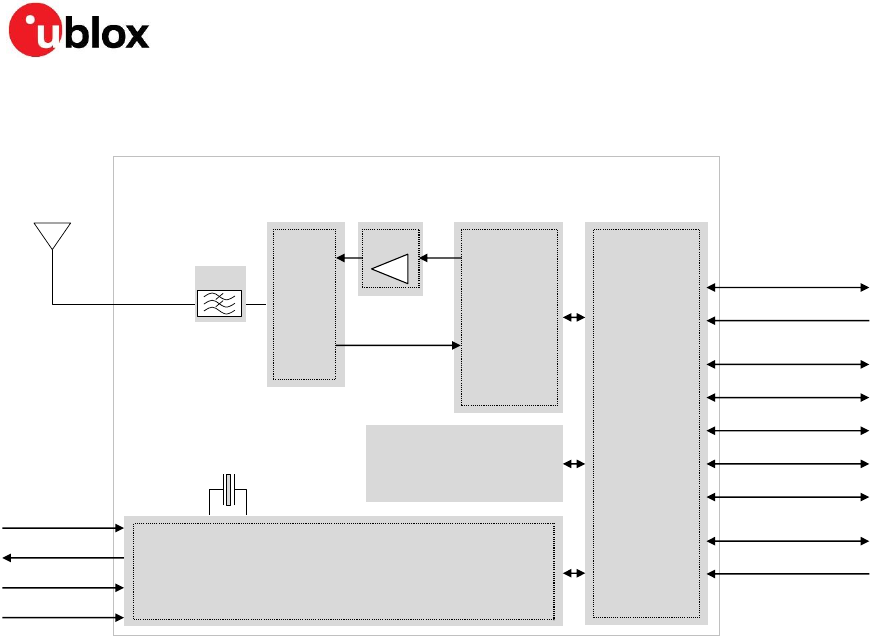
SARA-R4/N4 series - Data Sheet
UBX-16024152 - R11 Functional description Page 6 of 41
1.3 Block diagram
Memory
V_INT
RF
transceiver
Cellular
BaseBand
Processor
ANT
VCC (Supply)
USB
DDC (I2C)
SIM card detection
SIM
UART
Power-On
Reset
GPIOs
Antenna detection
Switch
PA
19.2 MHz
Power
Management
Filter
SDIO
SPI / Digital Audio
Figure 1: SARA-R4/N4 series block diagram
☞ SARA-R404M-00B and SARA-R410M-01B modules, i.e. the “00” and “01” product versions of the
SARA-R4/N4 series modules, do not support the following interfaces, which should be left
unconnected and should not be driven by external devices:
DDC (I2C) interface
SDIO interface
SPI interface
Digital audio interface
☞ SARA-R410M-02B, SARA-R412M-02B and SARA-N410-02B modules, i.e. the “02” product version
of the SARA-R4/N4 series modules, do not support the following interfaces, which should be left
unconnected and should not be driven by external devices:
SDIO interface
SPI interface
Digital audio interface

SARA-R4/N4 series - Data Sheet
UBX-16024152 - R11 Functional description Page 7 of 41
1.4 Product description
SARA-R4/N4 series modules include the following variants / product versions:
SARA-R404M LTE Cat M1 module,
mainly designed for operation in LTE band 13
SARA-R410M-01B LTE Cat M1 module,
mainly designed for operation in LTE bands 2, 4, 5, 12
SARA-R410M-02B LTE Cat M1 / NB1 module,
mainly designed for operation in LTE bands 2, 3, 4, 5, 8, 12, 13, 20, 28
SARA-R412M-02B LTE Cat M1 / NB1 and 2G module,
mainly designed for operation in LTE bands 2, 3, 4, 5, 8, 12, 13, 20 and 2G Quad-band
SARA-N410-02B LTE Cat NB1 module,
mainly designed for operation in LTE bands 2, 4, 5, 12, 13
Item
SARA-R404M
SARA-R410M
SARA-R412M
SARA-N410
Protocol stack
3GPP Release 13
3GPP Release 13
3GPP Release 13
3GPP Release 13
RAT
LTE Cat M1 Half-Duplex
LTE Cat M1 Half-Duplex
LTE Cat NB1 Half-Duplex1
LTE Cat M1 Half-Duplex
LTE Cat NB1 Half-Duplex
2G GSM / GPRS / EGPRS
LTE Cat NB1 Half-Duplex
Bands
LTE FDD bands:
Band 13 (750 MHz)
LTE FDD bands:
Band 12 (700 MHz)
Band 17 (700 MHz) 1
Band 28 (700 MHz) 1
Band 13 (750 MHz) 1
Band 20 (800 MHz) 1
Band 26 (850 MHz) 1
Band 18 (850 MHz) 1
Band 5 (850 MHz)
Band 19 (850 MHz) 1
Band 8 (900 MHz) 1
Band 4 (1700 MHz)
Band 3 (1800 MHz) 1
Band 2 (1900 MHz)
Band 25 (1900 MHz) 1
Band 1 (2100 MHz) 1
LTE TDD bands:
Band 39 (1900 MHz) 2
LTE FDD bands:
Band 12 (700 MHz)
Band 17 (700 MHz)
Band 28 (700 MHz)
Band 13 (750 MHz)
Band 20 (800 MHz)
Band 26 (850 MHz)
Band 18 (850 MHz)
Band 5 (850 MHz)
Band 19 (850 MHz)
Band 8 (900 MHz)
Band 4 (1700 MHz)
Band 3 (1800 MHz)
Band 2 (1900 MHz)
Band 25 (1900 MHz)
Band 1 (2100 MHz)
LTE TDD bands:
Band 39 (1900 MHz) 2
2G bands:
GSM 850 MHz
E-GSM 900 MHz
DCS 1800 MHz
PCS 1900 MHz
LTE FDD bands:
Band 12 (700 MHz)
Band 17 (700 MHz)
Band 28 (700 MHz)
Band 13 (750 MHz)
Band 20 (800 MHz)
Band 26 (850 MHz)
Band 18 (850 MHz)
Band 5 (850 MHz)
Band 19 (850 MHz)
Band 8 (900 MHz)
Band 4 (1700 MHz)
Band 3 (1800 MHz)
Band 2 (1900 MHz)
Band 25 (1900 MHz)
Band 1 (2100 MHz)
Power class
LTE Cat M1:
Class 3 (23 dBm)
LTE Cat M1 / NB11:
Class 3 (23 dBm)
LTE category M1 / NB1:
Class 3 (23 dBm)
2G GMSK:
Class 4 (33 dBm) for
GSM/E-GSM bands
Class 1 (30 dBm) for
DCS/PCS bands
2G 8-PSK:
Class E2 (27 dBm) for
GSM/E-GSM bands
Class E2 (26 dBm) for
DCS/PCS bands
LTE category NB1:
Class 3 (23 dBm)
1
Not supported by the “01” product version.
2
Supported in LTE category M1 only. Not supported by the “01” product version.

SARA-R4/N4 series - Data Sheet
UBX-16024152 - R11 Functional description Page 8 of 41
Item
SARA-R404M
SARA-R410M
SARA-R412M
SARA-N410
Data rate
LTE category M1:
up to 375 kb/s UL
up to 300 kb/s DL
LTE category M1:
up to 375 kb/s UL
up to 300 kb/s DL
LTE category NB11:
up to 62.5 kb/s UL
up to 27.2 kb/s DL
LTE category M1:
up to 375 kb/s UL
up to 300 kb/s DL
LTE category NB1:
up to 62.5 kb/s UL
up to 27.2 kb/s DL
GPRS multi-slot class 333:
Up to 85.6 kb/s UL
Up to 107 kb/s DL
EGPRS multi-slot class 333:
Up to 236.8 kb/s UL
Up to 296.0 kb/s DL
LTE category NB1:
up to 62.5 kb/s UL
up to 27.2 kb/s DL
Table 2: SARA-R4/N4 series LTE Cat M1, LTE Cat NB1, EGPRS, GPRS and GSM characteristics
1.5 AT command support
The SARA-R4/N4 series modules support AT commands according to the 3GPP standards
TS 27.007 [4], TS 27.005 [5], TS 27.010 [6], and the u-blox AT command extension.
☞ For the complete list of all supported AT commands and their syntax, see the SARA-R4/N4
series AT Commands Manual [1].
3
GPRS/EGPRS multi-slot class 33 implies a maximum of 5 slots in Down-Link and 4 slots in Up-Link with 6 slots in total.
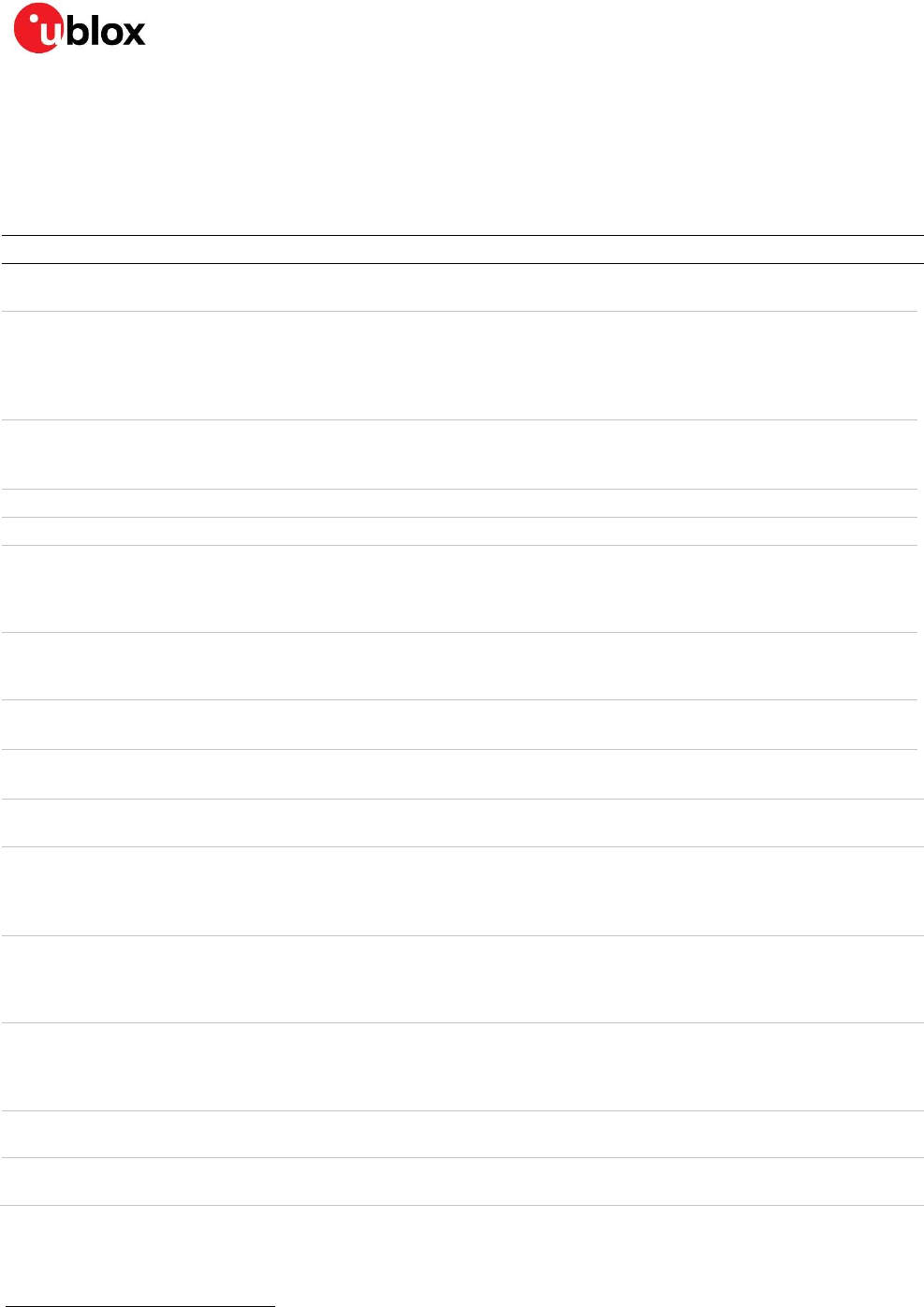
SARA-R4/N4 series - Data Sheet
UBX-16024152 - R11 Interfaces Page 9 of 41
1.6 Supported features
Table 3 lists some of the main features supported by SARA-R4/N4 series modules. For more details,
see the SARA-R4/N4 series System Integration Manual [2] and the SARA-R4/N4 series AT
Commands Manual [1].
Feature
Description
Network Indication
GPIO configured to indicate the network status: registered home network, registered roaming,
data call enabled, no service. The feature can be enabled through the +UGPIOC AT command.
Antenna Detection
The ANT_DET pin provides antenna presence detection capability, evaluating the resistance from
the ANT pin to GND by means of an external antenna detection circuit implemented on the
application board.
The antenna supervisor (i.e. antenna detection) feature can be enabled through the +UANTR AT
command.
Embedded TCP and UDP
stack
Embedded TCP/IP and UDP/IP stack including direct link mode for TCP and UDP sockets.
Sockets can be set in Direct Link mode to establish a transparent end-to-end communication
with an already connected TCP or UDP socket via the serial interface.
FTP
File Transfer Protocol functionality is supported via AT commands.
HTTP
Hyper-Text Transfer Protocol functionality is supported via AT commands.
Embedded SSL/TLS 4
With the support of X.509 certificates, embedded SSL/TLS provides server and client
authentication, data encryption, data signature and enables TCP/IP applications to communicate
over a secured and trusted connection. The feature can be configured and enabled by the
+USECMNG and +USECPRF AT commands.
MQTT 5
Message Queuing Telemetry Transport is an ISO standard publish-subscribe messaging protocol
designed for lightweight M2M communications over TCP. MQTT allows clients to communicate
one-to-one, one-to-many and many-to-one over a long-lived outgoing TCP connection.
Dual stack IPv4/IPv6
Capability to move between IPv4 and dual stack network infrastructures.
IPv4 and IPv6 addresses can be used.
Firmware update Over AT
commands (FOAT)
Firmware module update over AT command interface.
The feature can be enabled and configured through the +UFWUPD AT command.
Firmware update Over
The Air (uFOTA)
u-blox firmware module update over the LTE air interface client/server solution using LWM2M.
GNSS via modem 5
Full access to u-blox positioning chips and modules is available through a dedicated DDC (I2C)
interface.
This means that from any host processor, a single serial port can control the SARA-R4/N4 series
cellular module and the u-blox positioning chip or module.
Power Saving Mode (PSM)
The Power Saving Mode (PSM) feature, defined in 3GPP Rel.13, allows further reduction of the
module current consumption maximizing the amount of time a device can remain in PSM low
power deep sleep mode during periods of data inactivity. It can be activated and configured by the
+CPSMS AT command.
e-I-DRX 6
Extended Idle mode DRX, based on 3GPP Rel.13, reduces the amount of signaling overhead
decreasing the frequency of scheduled measurements and/or transmissions performed by the
module in idle mode. This in turn leads to a reduction in the module power consumption while
maintaining a perpetual connection with the base station.
Coverage Enhancements
Mode A
Coverage Enhancements Mode A, introduced in 3GPP Rel.13, is used to improve cell signal
penetration.
Coverage Enhancements
Mode B 7
Coverage Enhancements Mode B, introduced in 3GPP Rel.13, is used to further improve cell signal
penetration.
Table 3: Some of the main features supported by SARA-R4/N4 series modules
2 Interfaces
4
Not supported by “00” product version
5
Not supported by “00” and “01” product versions
6
The feature is disabled on “00” and “01” product versions due to network readiness
7
Not supported by “00”, “01” and “02” product versions

SARA-R4/N4 series - Data Sheet
UBX-16024152 - R11 Interfaces Page 10 of 41
2.1 Power management
2.1.1 Module supply input (VCC)
SARA-R4/N4 series modules must be supplied through the VCC pins by a DC power supply. Voltage
must be stable, because during operation the current drawn from VCC may vary significantly, based
on the power consumption profile of the LTE Cat M1, LTE Cat NB1 and the 2G radio access
technologies (described in the SARA-R4/N4 series System Integration Manual [2]).
SARA-R412M modules provide separate supply inputs over the three VCC pins:
VCC pins #52 and #53 represent the supply input for the internal RF Power Amplifier,
demanding most of the total current drawn of the module when RF transmission is enabled
during a call
VCC pin #51 represents the supply input for the internal baseband Power Management Unit,
demanding minor part of the total current drawn of the module when RF transmission is
enabled during a call
The three VCC pins of SARA-R404M, SARA-R410M and SARA-N410 modules are internally
connected to both the internal Power Amplifier and the internal baseband Power Management Unit.
It is important that the system power supply circuit is able to withstand the maximum pulse current
during a transmit burst at maximum power level (see Table 12).
2.1.2 Generic digital interfaces supply output (V_INT)
SARA-R4/N4 series modules provide a 1.8 V supply rail output on the V_INT pin, which is internally
generated when the module is switched on. The same voltage domain is used internally to supply the
generic digital interfaces of the module. The V_INT supply output can be used in place of an external
discrete regulator.
2.2 Antenna interface
2.2.1 Antenna RF interface (ANT)
The ANT pin represents the RF antenna interface of the module, with a characteristic impedance of
50 .
2.2.2 Antenna detection (ANT_DET)
The ANT_DET pin is an Analog to Digital Converter (ADC) input with a current source provided by
SARA-R4/N4 series modules to sense the antenna presence (as an optional feature). It evaluates the
resistance from the ANT pin to GND by means of an external antenna detection circuit implemented
on the application board (for more details, see the u-blox SARA-R4/N4 series System Integration
Manual [2] and the SARA-R4/N4 series AT Commands Manual [1]).

SARA-R4/N4 series - Data Sheet
UBX-16024152 - R11 Interfaces Page 11 of 41
2.3 System functions
2.3.1 Module power-on
SARA-R4/N4 series can be switched on using the following procedure:
Low level on the PWR_ON pin, which is normally set high by an internal pull-up, for a valid
time period when the applied VCC voltage is within the valid operating range (see sections
4.2.3 and 4.2.8). The PWR_ON line has to be driven by open drain, open collector or contact
switch.
2.3.2 Module power-off
SARA-R4/N4 series can be properly switched off, with storage of the current parameter settings and
a clean network detach, in one of these ways:
AT+CPWROFF command (see the SARA-R4/N4 series AT Commands Manual [1])
Low pulse on the PWR_ON pin for a valid time period (see section 4.2.8)
An abrupt shutdown occurs on SARA-R4/N4 series modules, without storage of the current
parameter settings and without a clean network detach, when:
the VCC supply drops below the extended operating range minimum limit
a low level is applied on the RESET_N pin, which is normally set high by an internal pull-up, for
a valid time period (see section 4.2.9). RESET_N line has to be driven by open drain, open
collector or contact switch.
2.3.3 Module reset
SARA-R4/N4 series modules can be reset (re-booted) by:
AT+CFUN command (see the SARA-R4/N4 series AT Commands Manual [1]). This causes an
“internal” or “software” reset of the module. The current parameter settings are saved in the
module’s non-volatile memory and a clean network detach is performed.
2.4 SIM
2.4.1 SIM interface
A SIM card interface is provided on the VSIM, SIM_IO, SIM_CLK, SIM_RST pins: the high-speed
SIM/ME interface is implemented as well as the automatic detection of the required SIM supporting
voltage.
Both 1.8 V and 3 V SIM types are supported (1.8 V and 3 V). Activation and deactivation with an
automatic voltage switch from 1.8 V to 3 V is implemented according to the ISO-IEC 7816-3
specifications. The SIM driver supports the PPS procedure for baud-rate selection, according to the
values proposed by the SIM card/chip.
2.4.2 SIM detection
The GPIO5 pin of SARA-R4/N4 series modules is a 1.8 V digital input which can be configured as an
external interrupt to detect the SIM card presence, as intended to be properly connected to the
mechanical switch of an external SIM card holder. For more details, see the SARA-R4/N4 series
System Integration Manual [2] and the SARA-R4/N4 series AT Commands Manual [1].

SARA-R4/N4 series - Data Sheet
UBX-16024152 - R11 Interfaces Page 12 of 41
2.5 Serial communication
The SARA-R4/N4 series provides the following serial communication interfaces:
UART interface: asynchronous serial interface available for the communication with a DTE
host application processor (AT commands, data communication, FW update by means of
FOAT)
USB interface: High-Speed USB 2.0 compliant interface available for communications with a
USB host application processor (AT commands, data communication, FW update by means
of the FOAT feature), for FW update by means of the u-blox tool and for diagnostics
SPI interface: Serial Peripheral Interface available for communications with an external
compatible device
SDIO interface: Secure Digital Input Output interface available for communications with a
compatible device
DDC interface: I2C bus compatible interface available for communications with external I2C
devices
2.5.1 UART interface
SARA-R4/N4 series modules include a 9-wire unbalanced asynchronous serial interface (UART) for
communication with an application host processor (AT commands and data communication).
☞ The UART is available only if the USB is not enabled as AT command / data communication
interface: UART and USB cannot be concurrently used for this purpose.
UART features are:
Complete serial port with RS-232 functionality conforming to the ITU-T V.24
Recommendation [9], with CMOS compatible signal levels (0 V for low data bit or ON state
and 1.8 V for high data bit or OFF state)
Data lines (RXD as output, TXD as input), hardware flow control lines (CTS as output, RTS as
input), modem status and control lines (DTR as input, DSR as output, DCD as output, RI as
output) are provided
The default baud rate is 115200 bit/s
The default frame format is 8N1 (8 data bits, no parity, 1 stop bit)
☞ Hardware flow control is not supported by the “00”, “01” and SARA-R410M-02B product
versions, but the RTS input line needs to be set low (= ON state) to communicate over the UART
interface on the “00” and “01” product versions.
The UART serial interface can be conveniently configured through AT commands. For more details,
see the SARA-R4/N4 series AT Commands Manual [1] and the SARA-R4/N4 series System
Integration Manual [2].
Multiplexer protocol
SARA-R4/N4 series modules include multiplexer functionality as per 3GPP TS 27.010 [6] on the
UART physical link.
This is a data link protocol which uses HDLC-like framing and operates between the module (DCE)
and the application processor (DTE), allowing a number of simultaneous sessions over the physical
link (UART).

SARA-R4/N4 series - Data Sheet
UBX-16024152 - R11 Interfaces Page 13 of 41
The following virtual channels are defined:
Channe
l 0:
for Multiplexer control
Channe
l 1:
for all AT commands, and non-Dial Up Network (non-DUN) data connections. UDP, TCP
data socket / data call connections through relevant AT commands.
Channe
l 2:
for Dial Up Network (DUN) data connection. It requires the host to have and use its
own TCP/IP stack. The DUN can be initiated on the modem side or terminal/host side.
Channe
l 3:
for u-blox GNSS data tunneling (not supported by the “00” and “01” product versions).
2.5.2 USB interface
SARA-R4/N4 series modules include a high-speed USB 2.0 compliant interface with a maximum
480 Mbit/s data rate according to the USB 2.0 specification [10] representing the main interface for
transferring high speed data with a host application processor. The module itself acts as a USB
device and can be connected to any USB host equipped with compatible drivers.
The USB is the most suitable interface for transferring high speed data between SARA-R4/N4 series
and a host processor, available for AT commands, data communication, FW upgrade by means of
the FOAT feature, FW upgrade by means of the u-blox dedicated tool and for diagnostic purposes.
The USB_D+ / USB_D- lines carry the USB data and signaling, while the VUSB_DET pin represents
the input to enable the USB interface by applying an external valid USB VBUS supply voltage (5.0 V
typical).
☞ The USB interface is available as an AT command / data communication interface only if an
external valid USB VBUS supply voltage (5.0 V typical) is applied at the VUSB_DET input of the
module since the switch-on of the module, and then held during normal operations. In this case,
the UART will not be available.
☞ If the USB interface is enabled, the module does not enter the low power deep sleep mode: the
external USB VBUS supply voltage needs to be removed from the VUSB_DET input of the
module to let it enter the Power Saving Mode defined in 3GPP Rel.13.
SARA-R4/N4 series modules provide by default a set of two USB functions:
AT commands and data communication
Diagnostic log
For more details regarding USB configurations / capabilities, see the SARA-R4/N4 series System
Integration Manual [2].
2.5.3 SPI interface
☞ The SPI interface is not supported by the “00”, “01” and “02” product versions.
SARA-R4/N4 series modules include a Serial Peripheral Interface for communications with
compatible external device.
The SPI interface can be made available as an alternative function, in a mutually exclusive way, over
the digital audio interface pins (I2S_WA / SPI_MOSI, I2S_RXD / SPI_MISO, I2S_CLK / SPI_CLK,
I2S_TXD / SPI_CS).

SARA-R4/N4 series - Data Sheet
UBX-16024152 - R11 Interfaces Page 14 of 41
2.5.4 SDIO interface
☞ The SDIO interface is not supported by the “00”, “01” and “02” product versions.
SARA-R4/N4 series modules include a 4-bit Secure Digital Input Output interface (SDIO_D0,
SDIO_D1, SDIO_D2, SDIO_D3, SDIO_CLK, and SDIO_CMD) designed to communicate with external
compatible SDIO devices.
2.5.5 DDC (I2C) interface
☞ The DDC (I2C) interface is not supported by the “00” and “01” product versions.
SARA-R4/N4 series modules include an I2C-bus compatible DDC interface (SDA, SCL) available to
communicate with a u-blox GNSS receiver and with external I2C devices as an audio codec: the
SARA-R4/N4 series module acts as an I2C master that can communicate with I2C slaves in
accordance with the I2C bus specifications [11].
The SDA and SCL pins have internal pull-up to V_INT, so there is no need of additional pull-up
resistors on the external application board.
2.6 Audio
☞ Audio is not supported by the “00”, “01” and “02” product versions.
SARA-R4/N4 series modules support VoLTE (Voice over LTE Cat M1 radio bearer) for providing audio
services.
SARA-R4/N4 series modules include an I2S digital audio interface to transfer digital audio data
to/from an external compatible audio device.
The digital audio interface can be made available as an alternative function, in a mutually exclusive
way, over the SPI interface pins (I2S_WA / SPI_MOSI, I2S_RXD / SPI_MISO, I2S_CLK / SPI_CLK,
I2S_TXD / SPI_CS).
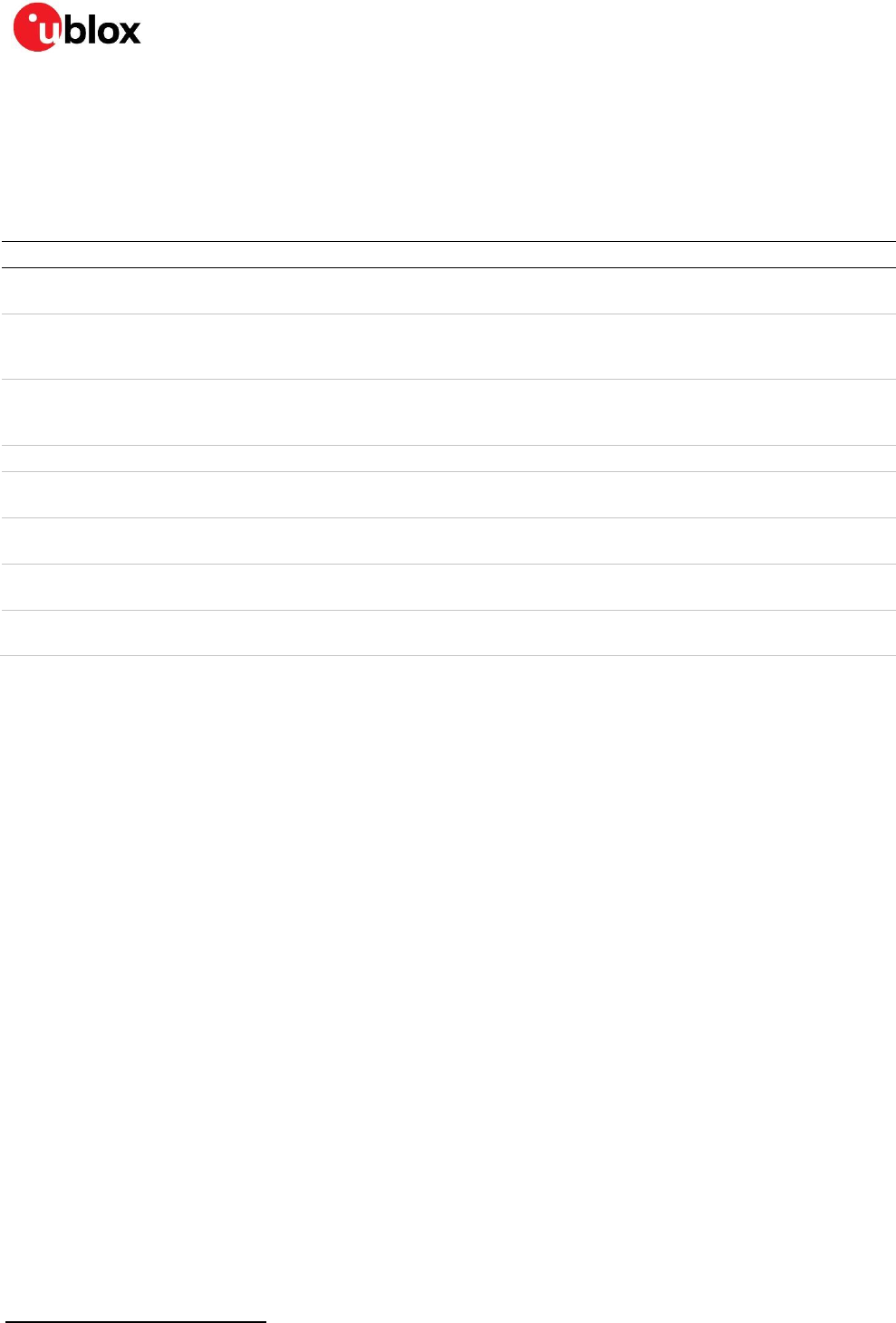
SARA-R4/N4 series - Data Sheet
UBX-16024152 - R11 Interfaces Page 15 of 41
2.7 GPIO
SARA-R4/N4 series modules include six pins (GPIO1-GPIO6) that can be configured as general
purpose input/output or to provide custom functions as summarized in Table 4 (for further details,
see the SARA-R4/N4 series System Integration Manual [2] and the GPIO section of the SARA-R4/N4
series AT Commands Manual [1]).
Function
Description
Default GPIO
Configurable GPIOs
Network status
indication
Network status: registered / data transmission, no
service
--
GPIO1
GNSS supply enable 8
Enable/disable the supply of a u-blox GNSS receiver
connected to the cellular module by the DDC (I2C)
interface
--
GPIO2
GNSS data ready 8
Sense when a u-blox GNSS receiver connected to the
module is ready for sending data by the DDC (I2C)
interface
--
GPIO3
SIM card detection
SIM card physical presence detection
--
GPIO5
Module status
indication
Module switched off or in PSM low power deep sleep
mode, versus active or connected mode
--
GPIO1, GPIO2, GPIO3,
GPIO4, GPIO5, GPIO6
General purpose
input
Input to sense high or low digital level
--
GPIO1, GPIO2, GPIO3,
GPIO4, GPIO5, GPIO6
General purpose
output
Output to set the high or the low digital level
--
GPIO1, GPIO2, GPIO3,
GPIO4, GPIO6
Pin disabled
Tri-state with an internal active pull-down enabled
GPIO1, GPIO2, GPIO3,
GPIO4, GPIO5, GPIO6
GPIO1, GPIO2, GPIO3,
GPIO4, GPIO5, GPIO6
Table 4: GPIO custom functions configuration
8
Not supported by “00” and “01” product versions
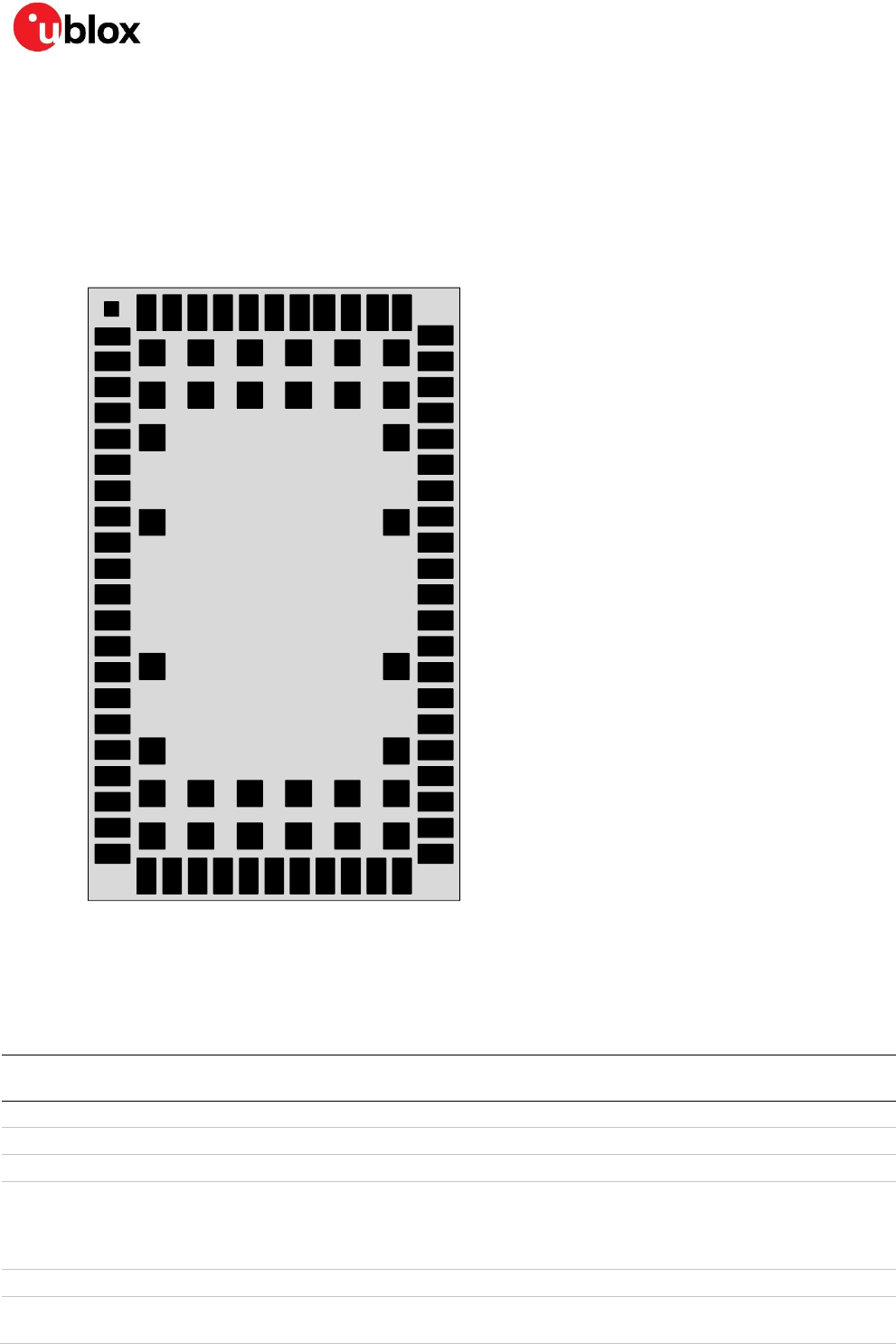
SARA-R4/N4 series - Data Sheet
UBX-16024152 - R11 Pin definition Page 16 of 41
3 Pin definition
3.1 Pin assignment
64 63 61 60 58 57 55 54
22 23 25 26 28 29 31 32
11
10
8
7
5
4
2
1
21
19
18
16
15
13
12
43
44
46
47
49
50
52
53
33
35
36
38
39
41
42
65 66 67 68 69 70
71 72 73 74 75 76
77 78
79 80
81 82
83 84
85 86 87 88 89 90
91 92 93 94 95 96
CTS
RTS
DCD
RI
V_INT
RSVD
GND
GPIO6
RESET_N
GPIO1
PWR_ON
RXD
TXD
3
20
17
14
9
6
24 27 30
51
48
45
40
37
34
5962 56
GND
GND
DSR
DTR
GND
VUSB_DET
GND
GND
USB_D-
USB_D+
RSVD
GND
GPIO2
GPIO3
SDA
SCL
GPIO4
GND
GND
GND
SDIO_D2
SDIO_CMD
SDIO_D0
SDIO_D1
GND
VCC
VCC
RSVD
I2S_TXD / SPI_CS
I2S_CLK / SPI_CLK
SIM_CLK
SIM_IO
VSIM
GPIO5
VCC
SDIO_D3
SDIO_CLK
SIM_RST
I2S_RXD / SPI_MISO
I2S_WA / SPI_MOSI
GND
GND
GND
GND
GND
GND
GND
GND
GND
ANT_DET
ANT
SARA-R4/N4
Top View
Pin 65-96: GND
Figure 2: SARA-R4/N4 series pin assignment (top view)
No
Name
Power
domain
I/O
Description
Remarks
1
GND
-
N/A
Ground
All the GND pins must be connected to ground
2
RSVD
-
N/A
RESERVED pin
Leave unconnected.
3
GND
-
N/A
Ground
All the GND pins must be connected to ground
4
V_INT
-
O
Generic Digital
Interfaces supply output
V_INT = 1.8 V (typical) generated by the module when is
switched on, outside low power PSM deep sleep mode.
See section 4.2.3 for detailed electrical specs.
Provide test point for diagnostic purposes.
5
GND
-
N/A
Ground
All the GND pins must be connected to ground
6
DSR
GDI
O
UART data set ready
Circuit 107 (DSR) in ITU-T V.24.
See section 4.2.12 for detailed electrical specs.
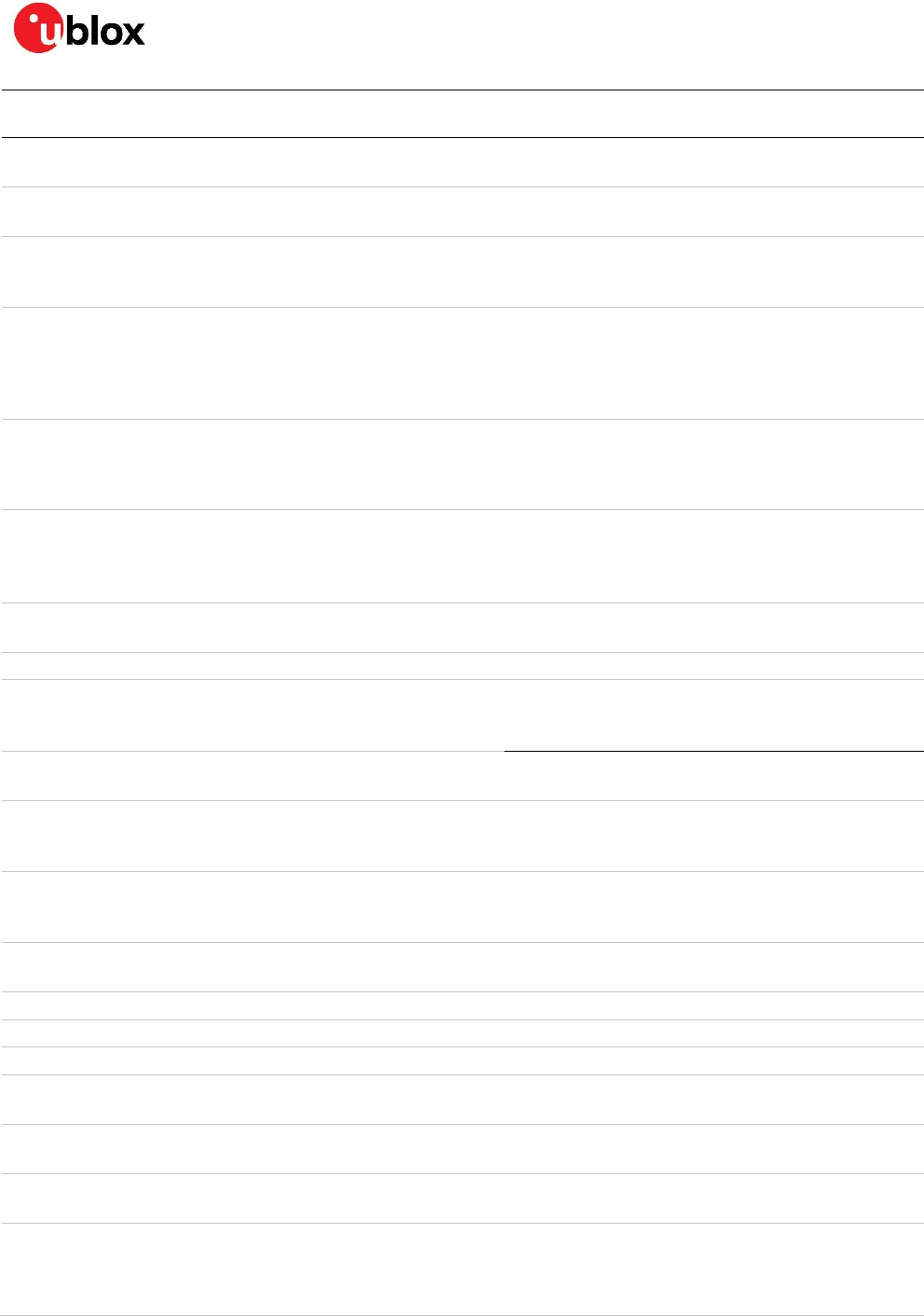
SARA-R4/N4 series - Data Sheet
UBX-16024152 - R11 Pin definition Page 17 of 41
No
Name
Power
domain
I/O
Description
Remarks
7
RI
GDI
O
UART ring indicator
Circuit 125 (RI) in ITU-T V.24.
See section 4.2.12 for detailed electrical specs.
8
DCD
GDI
O
UART data carrier detect
Circuit 109 (DCD) in ITU-T V.24.
See section 4.2.12 for detailed electrical specs.
9
DTR
GDI
I
UART data terminal
ready
Circuit 108/2 (DTR) in ITU-T V. 24.
Internal active pull-up to V_INT.
See section 4.2.12 for detailed electrical specs.
10
RTS
GDI
I
UART ready to send
Circuit 105 (RTS) in ITU-T V.24.
Internal active pull-up to V_INT.
Flow control is not supported by the “00”, “01” and
SARA-R410M-02B product versions
See section 4.2.12 for detailed electrical specs.
11
CTS
GDI
O
UART clear to send
Circuit 106 (CTS) in ITU-T V.24.
Flow control is not supported by the “00”, “01” and
SARA-R410M-02B product versions
See section 4.2.12 for detailed electrical specs.
12
TXD
GDI
I
UART data input
Circuit 103 (TxD) in ITU-T V.24.
Internal active pull-down to GND on “00”, “02” versions
Internal active pull-up to V_INT on “01” versions
See section 4.2.12 for detailed electrical specs.
13
RXD
GDI
O
UART data output
Circuit 104 (RxD) in ITU-T V.24.
See section 4.2.12 for detailed electrical specs.
14
GND
-
N/A
Ground
All the GND pins must be connected to ground
15
PWR_ON
POS
I
Power-on / power-off
input
Internal 200 k pull-up resistor.
See section 4.2.8 for detailed electrical specs.
Provide test point for diagnostic purposes.
16
GPIO1
GDI
I/O
GPIO
Configurable GPIO (see section 2.7).
See section 4.2.12 for detailed electrical specs.
17
VUSB_DET
USB
I
USB detect input
Input for VBUS (5 V typical) USB supply sense.
See section 4.2.11 for detailed electrical specs.
Provide test point for diagnostic purposes.
18
RESET_N
ERS
I
External reset input
Internal 37 k pull-up resistor to V_INT.
See section 4.2.9 for detailed electrical specs.
Provide test point for diagnostic purposes.
19
GPIO6
GDI
I/O
GPIO
Configurable GPIO (see section 2.7).
See section 4.2.12 for detailed electrical specs.
20
GND
-
N/A
Ground
All the GND pins must be connected to ground
21
GND
-
N/A
Ground
All the GND pins must be connected to ground
22
GND
-
N/A
Ground
All the GND pins must be connected to ground
23
GPIO2
GDI
I/O
GPIO
Configurable GPIO (see section 2.7).
See section 4.2.12 for detailed electrical specs.
24
GPIO3
GDI
I/O
GPIO
Configurable GPIO (see section 2.7).
See section 4.2.12 for detailed electrical specs.
25
GPIO4
GDI
I/O
GPIO
Configurable GPIO (see section 2.7).
See section 4.2.12 for detailed electrical specs.
26
SDA
DDC
I/O
I2C bus data line
Fixed open drain.
Internal 2.2 k pull-up resistor to V_INT.
Not supported by “00” and “01” product versions
See section 4.2.13 for detailed electrical specs.
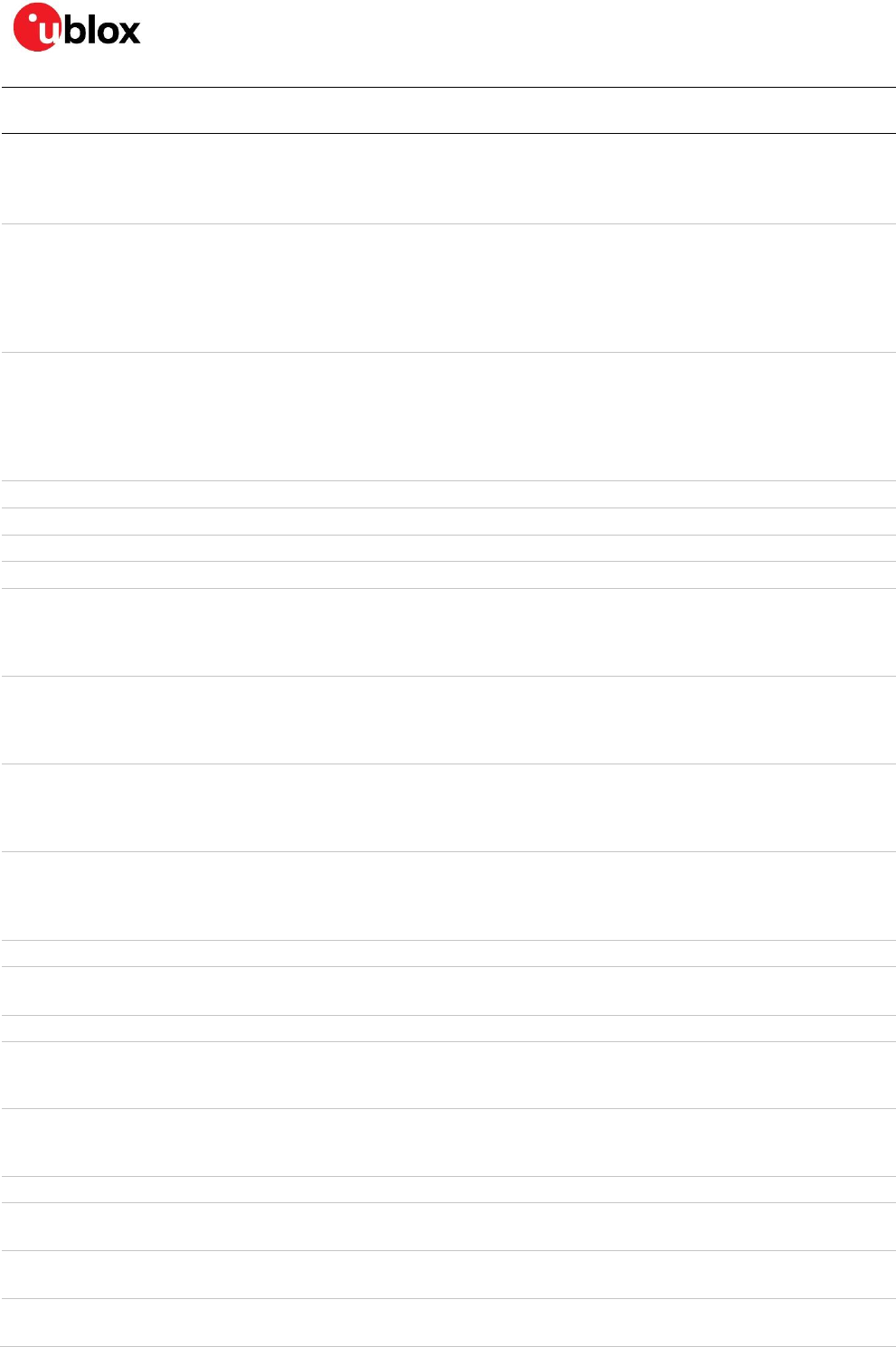
SARA-R4/N4 series - Data Sheet
UBX-16024152 - R11 Pin definition Page 18 of 41
No
Name
Power
domain
I/O
Description
Remarks
27
SCL
DDC
O
I2C bus clock line
Fixed open drain.
Internal 2.2 k pull-up resistor to V_INT.
Not supported by “00” and “01” product versions
See section 4.2.13 for detailed electrical specs.
28
USB_D-
USB
I/O
USB Data Line D-
90 nominal differential impedance.
Pull-up, pull-down and series resistors, as required by the
USB 2.0 specifications [10], are part of the USB pin driver
and shall not be provided externally.
See section 4.2.11 for detailed electrical specs.
Provide test point for diagnostic purposes.
29
USB_D+
USB
I/O
USB Data Line D+
90 nominal differential impedance.
Pull-up, pull-down and series resistors, as required by
USB 2.0 specifications [10], are part of the USB pin driver
and shall not be provided externally.
See section 4.2.11 for detailed electrical specs.
Provide test point for diagnostic purposes.
30
GND
-
N/A
Ground
All the GND pins must be connected to ground
31
RSVD
-
N/A
RESERVED pin
Leave unconnected.
32
GND
-
N/A
Ground
All the GND pins must be connected to ground
33
RSVD
-
N/A
RESERVED pin
This pin can be connected to GND.
34
I2S_WA /
SPI_MOSI
GDI
O /
O
I2S word alignment /
SPI Master Output Slave
Input
I2S word alignment, alternatively configurable as
SPI Master Output Slave Input
Not supported by “00”, “01” and “02” product versions
See section 4.2.12 for detailed electrical specs.
35
I2S_TXD /
SPI_CS
GDI
O /
O
I2S transmit data /
SPI Chip Select
I2S transmit data out, alternatively configurable as
SPI Chip Select
Not supported by “00”, “01” and “02” product versions
See section 4.2.12 for detailed electrical specs.
36
I2S_CLK /
SPI_CLK
GDI
O /
O
I2S clock /
SPI clock
I2S clock, alternatively configurable as
SPI clock
Not supported by “00”, “01” and “02” product versions
See section 4.2.12 for detailed electrical specs.
37
I2S_RXD /
SPI_MISO
GDI
I /
I
I2S receive data /
SPI Master Input Slave
Output
I2S receive data input, alternatively configurable as
SPI Master Input Slave Output
Not supported by “00”, “01” and “02” product versions
See section 4.2.12 for detailed electrical specs.
38
SIM_CLK
SIM
O
SIM clock
See section 4.2.10 for detailed electrical specs.
39
SIM_IO
SIM
I/O
SIM data
Internal 4.7 k pull-up resistor to VSIM.
See section 4.2.10 for detailed electrical specs.
40
SIM_RST
SIM
O
SIM reset
See section 4.2.10 for detailed electrical specs.
41
VSIM
-
O
SIM supply output
VSIM = 1.80 V typical or 2.95 V typical generated by the
module according to the external SIM card type.
See section 4.2.3 for detailed electrical specs.
42
GPIO5
GDI
I
SIM detection
SIM card presence detection input, alternatively
configurable as GPIO (see section 2.7).
See section 4.2.12 for detailed electrical specs.
43
GND
-
N/A
Ground
All the GND pins must be connected to ground
44
SDIO_D2
GDI
I/O
SDIO serial data [2]
Not supported by “00”, “01” and “02” product versions
See section 4.2.12 for detailed electrical specs.
45
SDIO_CLK
GDI
O
SDIO serial clock
Not supported by “00”, “01” and “02” product versions
See section 4.2.12 for detailed electrical specs.
46
SDIO_CMD
GDI
I/O
SDIO command
Not supported by “00”, “01” and “02” product versions
See section 4.2.12 for detailed electrical specs.
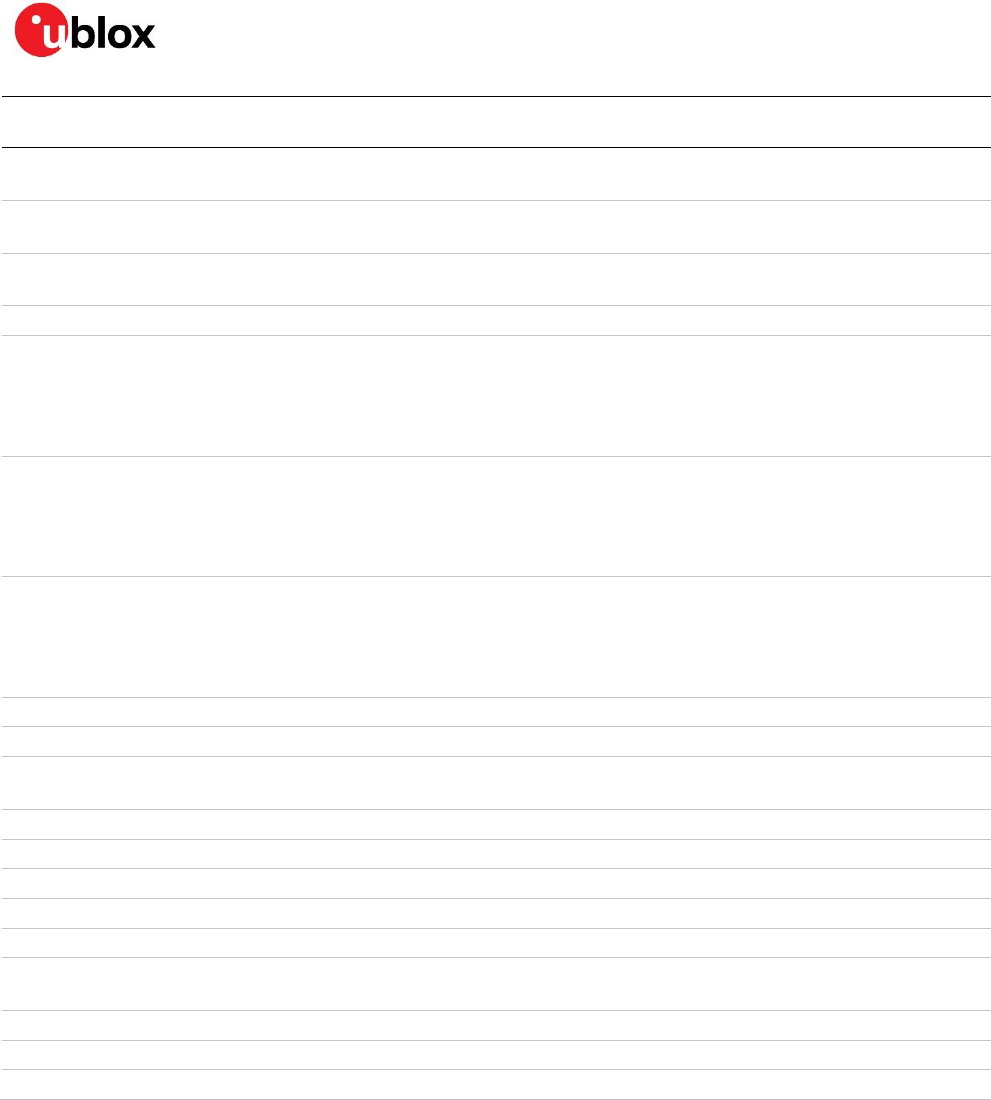
SARA-R4/N4 series - Data Sheet
UBX-16024152 - R11 Pin definition Page 19 of 41
No
Name
Power
domain
I/O
Description
Remarks
47
SDIO_D0
GDI
I/O
SDIO serial data [0]
Not supported by “00”, “01” and “02” product versions
See section 4.2.12 for detailed electrical specs.
48
SDIO_D3
GDI
I/O
SDIO serial data [3]
Not supported by “00”, “01” and “02” product versions
See section 4.2.12 for detailed electrical specs.
49
SDIO_D1
GDI
I/O
SDIO serial data [1]
Not supported by “00”, “01” and “02” product versions
See section 4.2.12 for detailed electrical specs.
50
GND
-
N/A
Ground
All the GND pins must be connected to ground
51
VCC
-
I
Module supply input
All VCC pins must be connected to external supply.
SARA-R404M, SARA-R410M and SARA-N410:
supply input for all internal parts.
SARA-R412M: supply input for internal BB PMU.
See section 4.2.3 and 4.2.4 for detailed specs.
52
VCC
-
I
Module supply input
All VCC pins must be connected to external supply.
SARA-R404M, SARA-R410M and SARA-N410:
supply input for all internal parts.
SARA-R412M: supply input for internal RF PA.
See section 4.2.3 and 4.2.4 for detailed specs.
53
VCC
-
I
Module supply input
All VCC pins must be connected to external supply.
SARA-R404M, SARA-R410M and SARA-N410:
supply input for all internal parts.
SARA-R412M: supply input for internal RF PA.
See section 4.2.3 and 4.2.4 for detailed specs.
54
GND
-
N/A
Ground
All the GND pins must be connected to ground
55
GND
-
N/A
Ground
All the GND pins must be connected to ground
56
ANT
-
I/O
RF input/output
50 nominal impedance.
See section 4.2.5 for detailed electrical specs.
57
GND
-
N/A
Ground
All the GND pins must be connected to ground
58
GND
-
N/A
Ground
All the GND pins must be connected to ground
59
GND
-
N/A
Ground
All the GND pins must be connected to ground
60
GND
-
N/A
Ground
All the GND pins must be connected to ground
61
GND
-
N/A
Ground
All the GND pins must be connected to ground
62
ANT_DET
ADC
I
Antenna detection
Antenna presence detection function.
See section 4.2.7 for detailed electrical specs.
63
GND
-
N/A
Ground
All the GND pins must be connected to ground
64
GND
-
N/A
Ground
All the GND pins must be connected to ground
65-96
GND
-
N/A
Ground
All the GND pins must be connected to ground
Table 5: SARA-R4/N4 series pin-out
☞ For more information about the pin-out, see the u-blox SARA-R4/N4 series System Integration
Manual [2].
☞ See Appendix A for an explanation of the abbreviations and terms used.
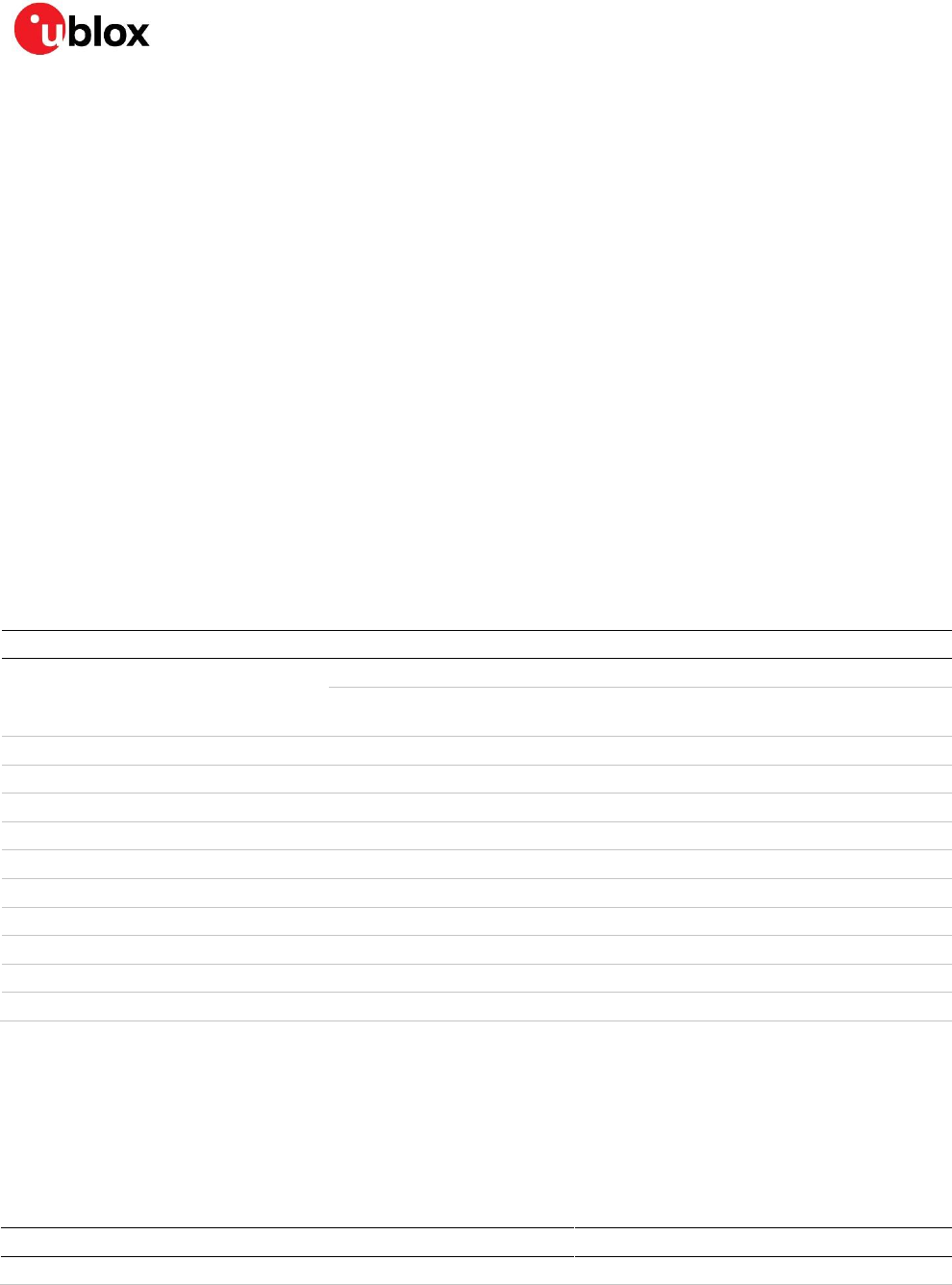
SARA-R4/N4 series - Data Sheet
UBX-16024152 - R11 Electrical specifications Page 20 of 41
4 Electrical specifications
⚠ Stressing the device above one or more of the ratings listed in the Absolute Maximum Rating
section may cause permanent damage. These are stress ratings only. Operating the module at
these or at any conditions other than those specified in the Operating Conditions sections
(section 4.2) of the specification should be avoided. Exposure to Absolute Maximum Rating
conditions for extended periods may affect device reliability.
☞ Operating condition ranges define those limits within which the functionality of the device is
guaranteed.
☞ Electrical characteristics are defined according to the verification on a representative number of
samples or according to the simulation.
☞ Where application information is given, it is advisory only and does not form part of the
specification.
4.1 Absolute maximum rating
☞ Limiting values given below are in accordance with the Absolute Maximum Rating System
(IEC 134).
Symbol
Description
Condition
Min.
Max.
Unit
VCC
Module supply voltage
Input DC voltage at VCC pins (SARA-R404M)
-0.5
6.0
V
Input DC voltage at VCC pins
(SARA-R404M, SARA-R410M and SARA-N410)
-0.5
5.2
V
VUSB_DET
USB detection pin
Input DC voltage at VUSB_DET pin
-0.5
5.5
V
USB
USB D+/D- pins
Input DC voltage at USB interface pins
-0.3
3.6
V
GDI
Generic digital interfaces
Input DC voltage at Generic digital interfaces pins
-0.3
2.3
V
DDC
DDC interface
Input DC voltage at DDC interface pins
-0.3
2.3
V
SIM
SIM interface
Input DC voltage at SIM interface pins
-0.3
3.5
V
ERS
External reset input
Input DC voltage at RESET_N pin
-0.5
2.1
V
POS
Power-on input
Input DC voltage at PWR_ON pin
-0.5
2.1
V
ADC
Antenna detection input
Input DC voltage at ANT_DET pin
-0.5
4.3
V
Rho_ANT
Antenna ruggedness
Output RF load mismatch ruggedness at ANT pins
10:1
VSWR
Tstg
Storage temperature
-40
+85
°C
Table 6: Absolute maximum ratings
⚠ The product is not protected against overvoltage or reversed voltages. If necessary, voltage
spikes exceeding the voltage specifications given in the table above, must be limited to values
within the specified boundaries by using appropriate protection devices.
4.1.1 Maximum ESD
Parameter
Min
Typical
Max
Unit
Remarks
ESD sensitivity for all pins
1000
V
Human Body Model according to JESD22-A114
Table 7: Maximum ESD ratings
⚠ u-blox cellular modules are Electrostatic Sensitive Devices and require special precautions when
handling. See section 7.4 for ESD handling instructions.
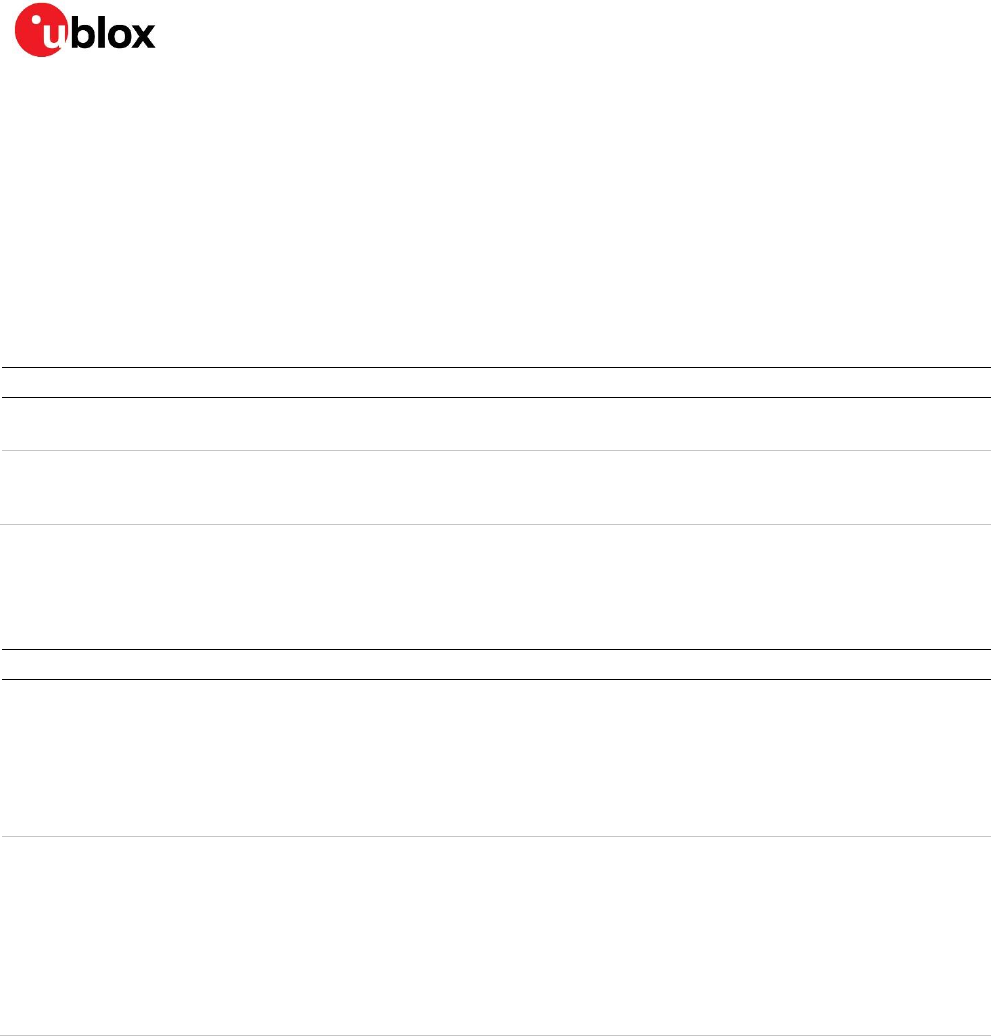
SARA-R4/N4 series - Data Sheet
UBX-16024152 - R11 Electrical specifications Page 21 of 41
4.2 Operating conditions
☞ Unless otherwise indicated, all operating condition specifications are at an ambient
temperature of +25 °C.
⚠ Operation beyond the operating conditions is not recommended and extended exposure beyond
them may affect device reliability.
4.2.1 Operating temperature range
Parameter
Min.
Typical
Max.
Unit
Remarks
Normal operating temperature
–20
+25
+65
°C
Normal operating temperature range
(fully functional and meet 3GPP specifications)
Extended operating
temperature
–40
+85
°C
Extended operating temperature range
(RF performance may be affected outside normal operating
range, though module is fully functional)
Table 8: Environmental conditions
4.2.2 Thermal parameters
Symbol
Parameter
Min.
Typical
Max.
Units
Remarks
ΨM-A
Module-to-Ambient
thermal parameter
10
°C/W
Thermal characterization parameter
ΨM-A = (TM – TA) / PH proportional to the temperature difference
between the internal temperature sensor of the module I and
the ambient temperature (TA), produced by the module heat
power dissipation (PH), with the module mounted on a 79 x 62 x
1.41 mm 4-Layer PCB with a high coverage of copper, in still air
conditions
ΨM-C
Module-to-Case
thermal parameter
2
°C/W
Thermal characterization parameter
ΨM-C = –TM - TC) / PH proportional to the temperature difference
between the internal temperature sensor of the modI(TM) and
the ambient temperature (TC), produced by the module heat
power dissipation (PH), with the module mounted on a 79 x 62 x
1.41 mm 4-Layer PCB with a high coverage of copper, with a
robust aluminum heat-sink and with forced air ventilation, i.e.
reducing to a value close to 0 °C/W the thermal resistance
from the case of the module to the ambient
Table 9: Thermal characterization parameters of the module
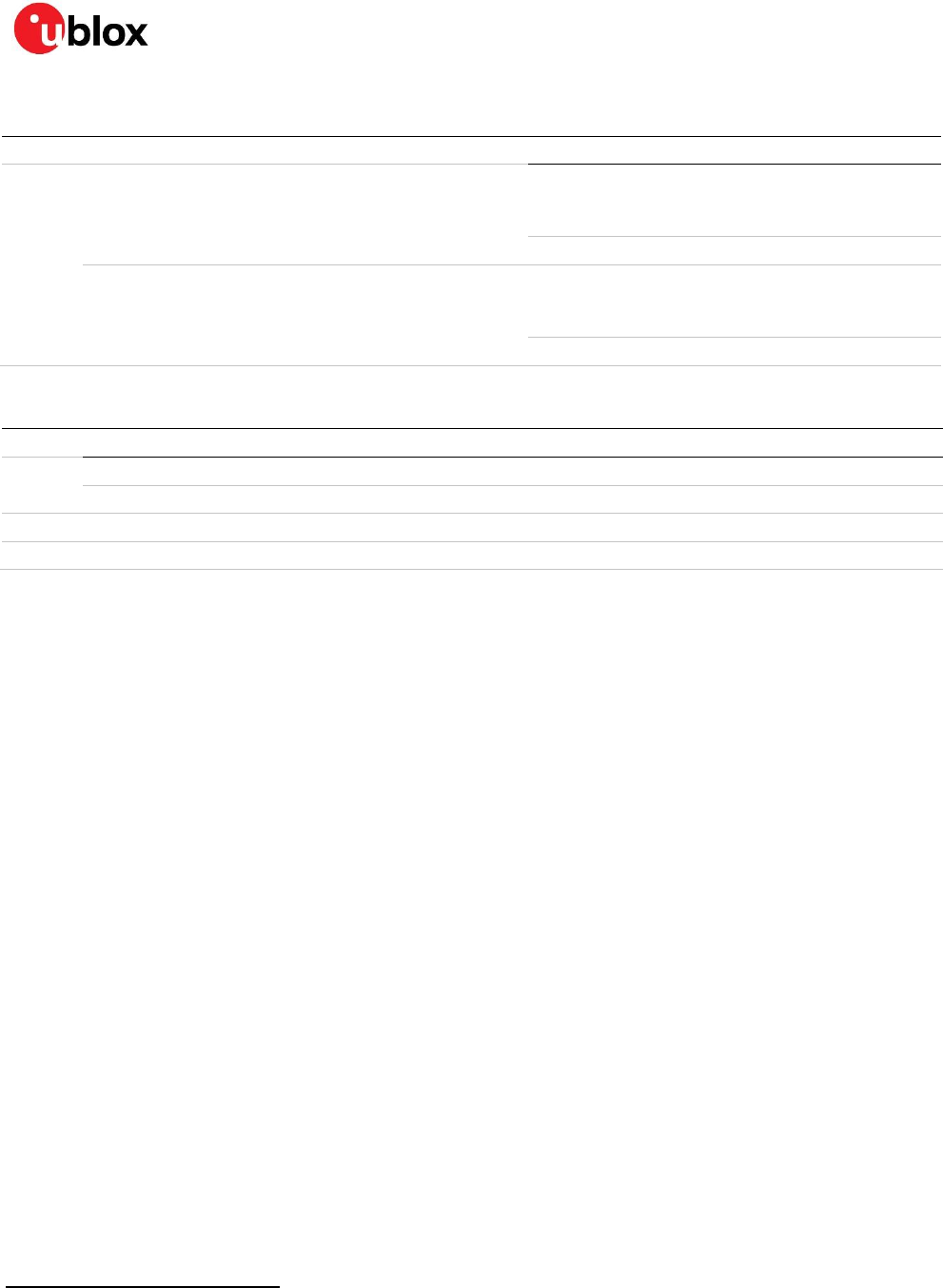
SARA-R4/N4 series - Data Sheet
UBX-16024152 - R11 Electrical specifications Page 22 of 41
4.2.3 Supply/power pins
Symbol
Parameter
Module
Min.
Typical
Max.
Unit
VCC
Module supply normal operating input voltage 9
SARA-R404M
SARA-R410M
SARA-N410
3.2
3.8
4.2
V
SARA-R412M
3.2
3.8
4.5
V
Module supply extended operating input voltage 10
SARA-R404M
SARA-R410M
SARA-N410
3.0
3.8
4.3
V
SARA-R412M
3.0
3.8
4.5
V
Table 10: Input characteristics of the Supply/Power pins
Symbol
Parameter
Module
Min.
Typical
Max.
Unit
VSIM
SIM supply output voltage with 1.8 V external SIM
All
1.80
V
SIM supply output voltage with 3.0 V external SIM
All
2.95
V
V_INT
Generic Digital Interfaces supply output voltage
All
1.80
V
I_INT
Generic Digital Interfaces supply output current capability
All
70
mA
Table 11: Output characteristics of the Supply/Power pins
9
Input voltage at VCC must be above the normal operating range minimum limit to switch on the module. RF performance
may be affected when the input voltage at VCC drops below the herein stated normal operating range minimum limit, though
the module is still fully functional.
10
Ensure that input voltage at VCC never drops below the extended operating range minimum limit during module operation:
the cellular module may switch off when the VCC voltage value drops below the herein stated extended operating range
minimum limit.
11
Typical values with a matched antenna.
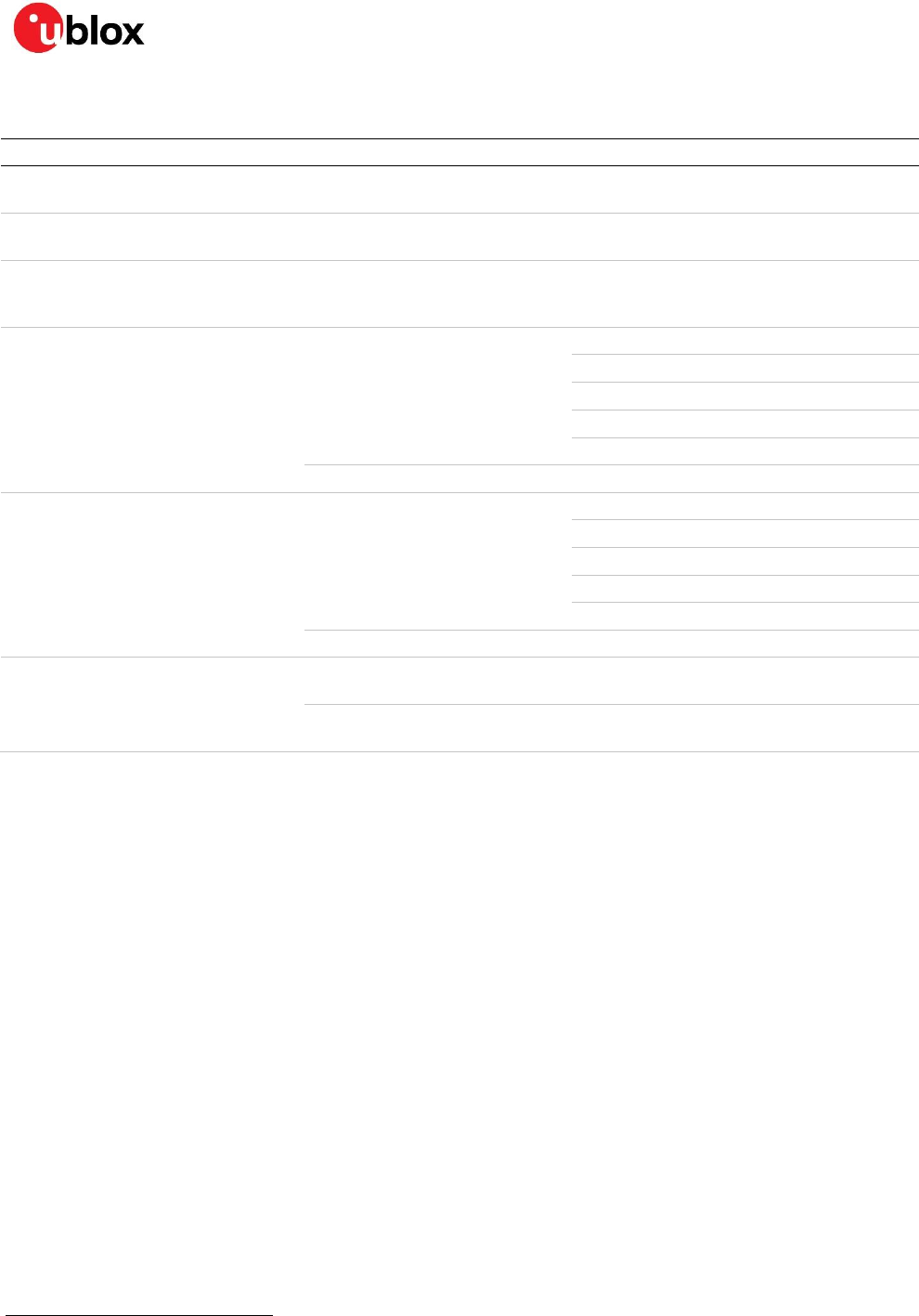
SARA-R4/N4 series - Data Sheet
UBX-16024152 - R11 Electrical specifications Page 23 of 41
4.2.4 Current consumption
Mode
Condition
Tx power
Min
Typ11
Max12
Unit
Power Off Mode
(module switched off)
Averaged current value
6
µA
PSM Deep Sleep Mode
(low power mode)
Averaged current value
8
µA
Active Mode
(Power Saving Mode disabled, Module
registered with network)
Averaged current value
9
mA
LTE Cat NB1 Connected Mode
(Data Tx / Rx)
Averaged current value
Minimum
60
mA
0 dBm
65
mA
12 dBm
80
mA
18 dBm
100
mA
Maximum
140
mA
Peak current value during Tx
Maximum
490
mA
LTE Cat M1 Connected Mode
(Data Tx / Rx)
Averaged current value
Minimum
100
mA
0 dBm
105
mA
12 dBm
125
mA
18 dBm
150
mA
Maximum
190
mA
Peak current value during Tx
Maximum
490
mA
2G Connected Mode
(Data Tx / Rx)
Averaged current during a GMSK 1-
slot Tx call, 850/900 MHz bands
Maximum
200
mA
Peak current during a GMSK 1-slot
Tx burst, 850/900 MHz bands
Maximum
1.5
1.9
A
Table 12: Module VCC current consumption
13
11
Typical values with a matched antenna.
12
Maximum values with a mismatched antenna.
13
All values with VCC = 3.8 V, with UART connected and USB disconnected.
13
All values with VCC = 3.8 V, with UART connected and USB disconnected.
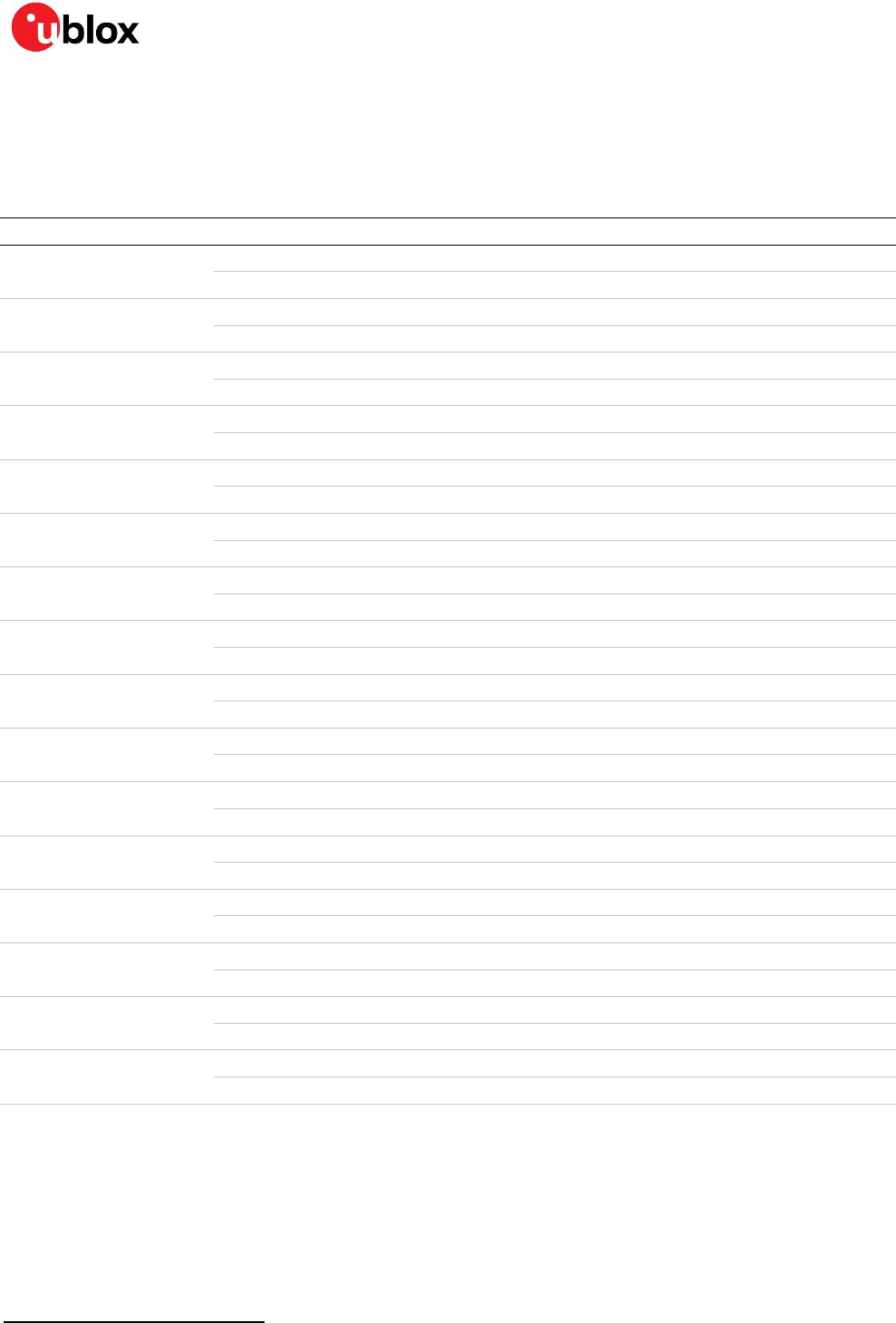
SARA-R4/N4 series - Data Sheet
UBX-16024152 - R11 Electrical specifications Page 24 of 41
4.2.5 LTE RF characteristics
The LTE bands supported by SARA-R4/N4 series modules are defined in Table 2, while the following
Table 13 describes the Transmitting and Receiving frequencies according to 3GPP TS 36.521-1 [7].
Parameter
Min.
Max.
Unit
Remarks
Frequency range
FDD Band 12 (700 MHz)
Uplink
699
716
MHz
Module transmit
Downlink
729
746
MHz
Module receive
Frequency range
FDD Band 17 (700 MHz)
Uplink
704
716
MHz
Module transmit
Downlink
734
746
MHz
Module receive
Frequency range
FDD Band 28 (700 MHz)
Uplink
703
748
MHz
Module transmit
Downlink
758
803
MHz
Module receive
Frequency range
FDD Band 13 (700 MHz)
Uplink
777
787
MHz
Module transmit
Downlink
746
756
MHz
Module receive
Frequency range
FDD Band 20 (800 MHz)
Uplink
832
862
MHz
Module transmit
Downlink
791
821
MHz
Module receive
Frequency range
FDD Band 26 (850 MHz)
Uplink
814
849
MHz
Module transmit
Downlink
859
894
MHz
Module receive
Frequency range
FDD Band 18 (850 MHz)
Uplink
815
830
MHz
Module transmit
Downlink
860
875
MHz
Module receive
Frequency range
FDD Band 5 (850 MHz)
Uplink
824
849
MHz
Module transmit
Downlink
869
894
MHz
Module receive
Frequency range
FDD Band 19 (850 MHz)
Uplink
830
845
MHz
Module transmit
Downlink
875
890
MHz
Module receive
Frequency range
FDD Band 8 (900 MHz)
Uplink
880
915
MHz
Module transmit
Downlink
925
960
MHz
Module receive
Frequency range
FDD Band 4 (1700 MHz)
Uplink
1710
1755
MHz
Module transmit
Downlink
2110
2155
MHz
Module receive
Frequency range
FDD Band 3 (1800 MHz)
Uplink
1710
1785
MHz
Module transmit
Downlink
1805
1880
MHz
Module receive
Frequency range
FDD Band 2 (1900 MHz)
Uplink
1850
1910
MHz
Module transmit
Downlink
1930
1990
MHz
Module receive
Frequency range
FDD Band 25 (1900 MHz)
Uplink
1850
1915
MHz
Module transmit
Downlink
1930
1995
MHz
Module receive
Frequency range
TDD Band 39 (1900 MHz)14
Uplink
1880
1920
MHz
Module transmit
Downlink
1880
1920
MHz
Module receive
Frequency range
FDD Band 1 (2100 MHz)
Uplink
1920
1980
MHz
Module transmit
Downlink
2110
2170
MHz
Module receive
Table 13: LTE operating RF frequency bands
SARA-R4/N4 series modules include a UE Power Class 3 LTE Cat M1 / NB1 transmitter (see Table 2),
with output power and characteristics according to 3GPP TS 36.521-1 [7].
SARA-R4/N4 series modules LTE receiver characteristics are compliant to 3GPP TS 36.521-1 [7], with
LTE conducted receiver sensitivity performance described in Table 14 and Table 15.
14
Supported in LTE category M1 only
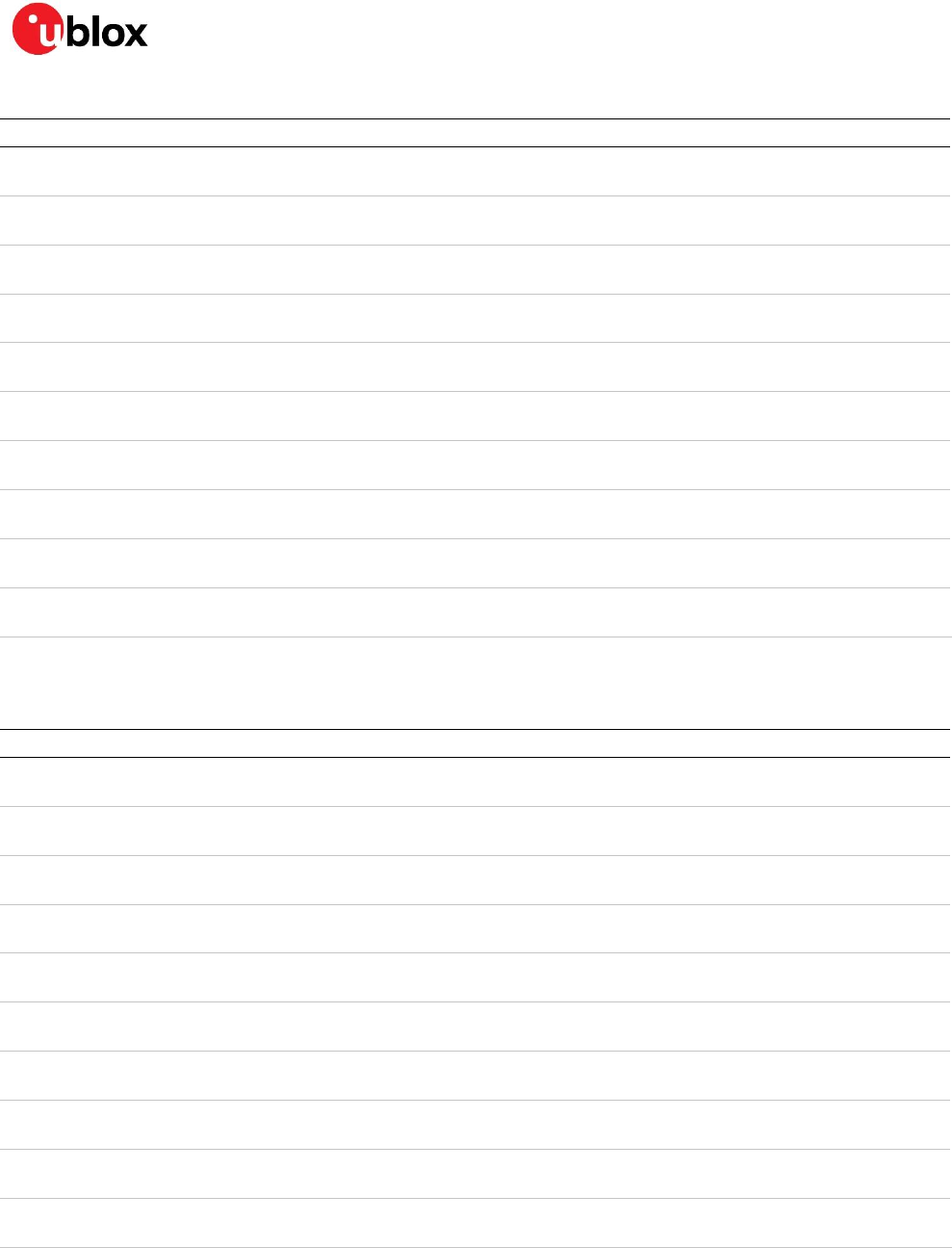
SARA-R4/N4 series - Data Sheet
UBX-16024152 - R11 Electrical specifications Page 25 of 41
Parameter
Min.
Typical
Max.
Unit
Remarks
Receiver input sensitivity
Band 12 / 17 (700 MHz)
–107.0
dBm
Without repetitions
Receiver input sensitivity
Band 28 (700 MHz)
–105.0
dBm
Without repetitions
Receiver input sensitivity
Band 13 (700 MHz)
–105.0
dBm
Without repetitions
Receiver input sensitivity
Band 20 (800 MHz)
–105.0
dBm
Without repetitions
Receiver input sensitivity
Band 5 / 18 / 19 / 26 (850 MHz)
–105.5
dBm
Without repetitions
Receiver input sensitivity
Band 8 (900 MHz)
–106.5
dBm
Without repetitions
Receiver input sensitivity
Band 4 (1700 MHz)
–107.5
dBm
Without repetitions
Receiver input sensitivity
Band 3 (1800 MHz)
–106.0
dBm
Without repetitions
Receiver input sensitivity
Band 2 / 25 (1900 MHz)
–106.0
dBm
Without repetitions
Receiver input sensitivity
Band 1 (2100 MHz)
–107.5
dBm
Without repetitions
Condition: 50 source, throughput > 95%, QPSK modulation, other settings as per 3GPP TS 36.521-1 [7]
Table 14: LTE Cat M1 receiver sensitivity performance
Parameter
Min.
Typical
Max.
Unit
Remarks
Receiver input sensitivity
Band 12 / 17 (700 MHz)
–113.5
dBm
Without repetitions
Receiver input sensitivity
Band 28 (700 MHz)
–112.0
dBm
Without repetitions
Receiver input sensitivity
Band 13 (700 MHz)
–112.0
dBm
Without repetitions
Receiver input sensitivity
Band 20 (800 MHz)
–112.0
dBm
Without repetitions
Receiver input sensitivity
Band 5 / 18 / 19 / 26 (850 MHz)
–112.5
dBm
Without repetitions
Receiver input sensitivity
Band 8 (900 MHz)
–113.0
dBm
Without repetitions
Receiver input sensitivity
Band 4 (1700 MHz)
–114.0
dBm
Without repetitions
Receiver input sensitivity
Band 3 (1800 MHz)
–113.0
dBm
Without repetitions
Receiver input sensitivity
Band 2 / 25 (1900 MHz)
–113.0
dBm
Without repetitions
Receiver input sensitivity
Band 1 (2100 MHz)
–114.0
dBm
Without repetitions
Condition: 50 source, throughput > 95%, other settings as per 3GPP TS 36.521-1 [7]
Table 15: LTE Cat NB1 receiver sensitivity performance
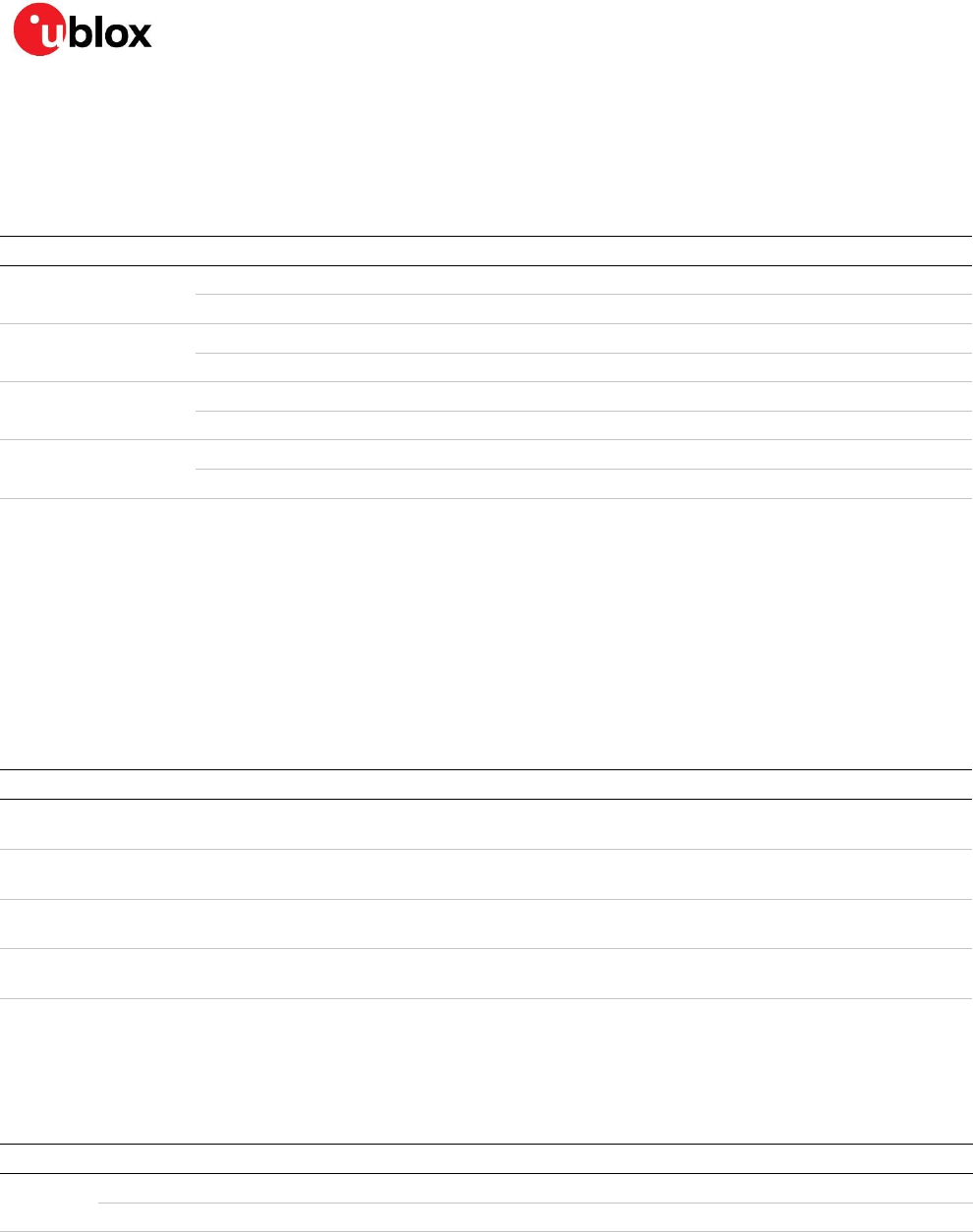
SARA-R4/N4 series - Data Sheet
UBX-16024152 - R11 Electrical specifications Page 26 of 41
4.2.6 2G RF characteristics
The 2G bands supported by SARA-R4/N4 series modules are defined in Table 2, while the following
Table 16 describes the Transmitting and Receiving frequencies according to 3GPP TS 51.010-1 [8].
Parameter
Min
Max
Unit
Remarks
Frequency range
GSM 850
Uplink
824
849
MHz
Module transmit
Downlink
869
894
MHz
Module receive
Frequency range
E-GSM 900
Uplink
880
915
MHz
Module transmit
Downlink
925
960
MHz
Module receive
Frequency range
DCS 1800
Uplink
1710
1785
MHz
Module transmit
Downlink
1805
1880
MHz
Module receive
Frequency range
PCS 1900
Uplink
1850
1910
MHz
Module transmit
Downlink
1930
1990
MHz
Module receive
Table 16: 2G operating RF frequency bands
SARA-R4/N4 series modules include a GMSK Power Class 4 transmitter for GSM 850 and E-GSM
900 bands, a GMSK Power Class 1 transmitter for DCS 1800 and PCS 1900 bands, a 8-PSK Power
Class E2 transmitter for all 2G bands (see Table 2), with output power and characteristics according
to 3GPP TS 51.010-1 [8].
SARA-R4/N4 series modules 2G receiver characteristics are compliant to 3GPP TS 51.010-1 [8], with
conducted receiver sensitivity performance described in Table 17.
Parameter
Min
Typical
Max
Unit
Remarks
Receiver input sensitivity
GSM 850
-109
dBm
Downlink RF level @ BER Class II < 2.4 %
Receiver input sensitivity
E-GSM 900
-109
dBm
Downlink RF level @ BER Class II < 2.4 %
Receiver input sensitivity
DCS 1800
-109
dBm
Downlink RF level @ BER Class II < 2.4 %
Receiver input sensitivity
PCS 1900
-109
dBm
Downlink RF level @ BER Class II < 2.4 %
Condition: 50 source
Table 17: 2G receiver sensitivity performance
4.2.7 ANT_DET pin characteristics
Pin Name
Parameter
Min.
Typ.
Max.
Unit
Remarks
ANT_DET
Output DC current pulse value
35
µA
Output DC current pulse time length
1160
µs
Table 18: ANT_DET pin characteristics
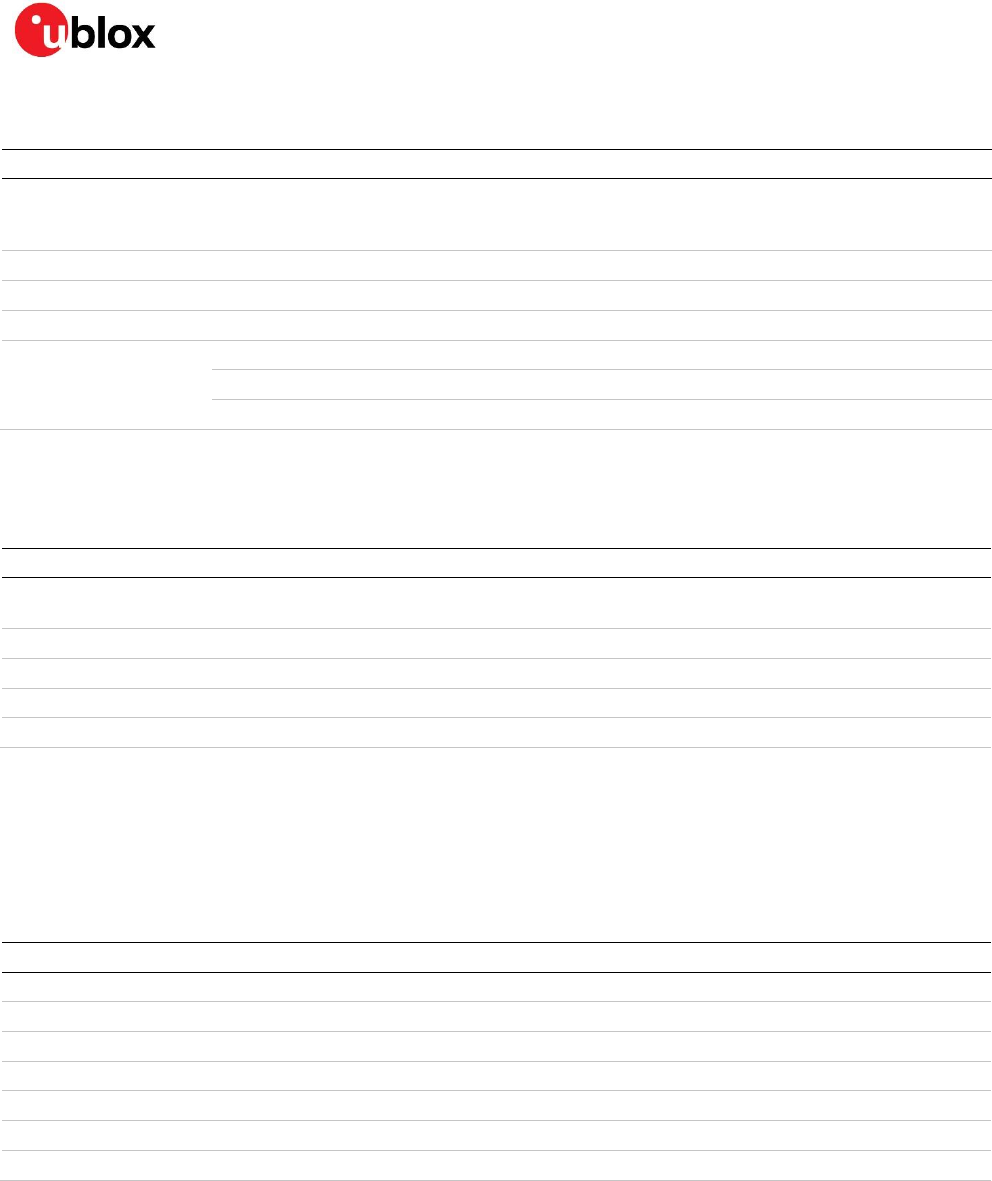
SARA-R4/N4 series - Data Sheet
UBX-16024152 - R11 Electrical specifications Page 27 of 41
4.2.8 PWR_ON pin
Parameter
Min.
Typical
Max.
Unit
Remarks
Internal supply for
PWR_ON Input Signal
1.8
V
The PWR_ON input is pulled up to an internal voltage rail
minus a diode drop: the voltage value present at
PWR_ON input pin is normally 0.8 V typical.
Low-level input
-0.30
0.35
V
Pull-up resistance
150
200
250
k
Internal active pull-up
Input leakage current
-0.20
0.20
µA
PWR_ON low time
0.15
3.20
s
Low time to switch on the module from power off mode
0.15
3.20
s
Low time to wake-up the module from PSM deep sleep
1.50
s
Low time to switch off the module
Table 19: PWR_ON pin characteristics
4.2.9 RESET_N pin
Parameter
Min.
Typical
Max.
Unit
Remarks
Internal supply for
RESET_N Input Signal
1.8
V
Low-level input
-0.30
0.63
V
Pull-up resistance
37
k
Internal active pull-up
Input leakage current
-0.20
0.20
µA
RESET_N low time
10
s
Low time to switch off the module
Table 20: RESET_N pin characteristics
4.2.10 SIM pins
The SIM pins are a dedicated interface to the external SIM card/chip. The electrical characteristics
fulfill the regulatory specification requirements. The values in Table 21 are for information only.
Parameter
Min.
Typ.
Max.
Unit
Remarks
Low-level input
-0.30
0.2*VSIM
V
High-level input
0.7*VSIM
VSIM+0.3
V
Low-level output
0
0.4
V
Max value at IOL = +2.0 mA
High-level output
0.8*VSIM
VSIM
V
Max value at IOL = +2.0 mA
Internal pull-up resistor on SIM_IO
4.7
k
Internal pull-up to VSIM supply
Input leakage current
-2
2
µA
VIN =0 V or VIN =VSIM
Clock frequency on SIM_CLK
4.8
MHz
Table 21: SIM pin characteristics
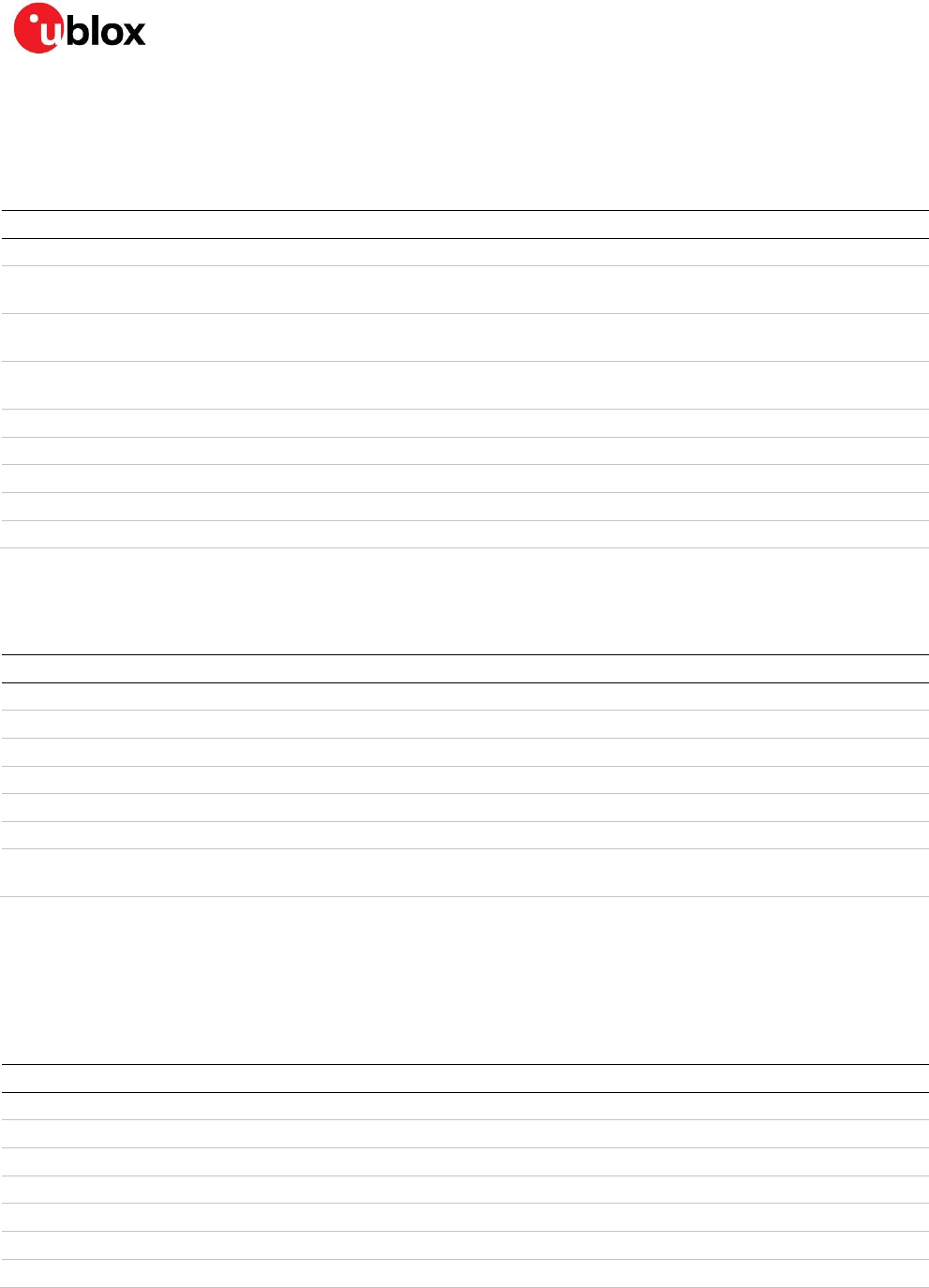
SARA-R4/N4 series - Data Sheet
UBX-16024152 - R11 Electrical specifications Page 28 of 41
4.2.11 USB pins
USB data lines (USB_D+/ USB_D–) are compliant to the USB 2.0 high-speed specification. See the
Universal Serial Bus Revision 2.0 specification [10] for detailed electrical characteristics.
Parameter
Min.
Typical
Max.
Unit
Remarks
USB detection voltage on pin VUSB_DET
4.40
5.00
5.25
V
High-speed squelch detection threshold
(input differential signal amplitude)
100
150
mV
High speed disconnect detection threshold
(input differential signal amplitude)
525
625
mV
High-speed data signaling input
common mode voltage range
-50
500
mV
High-speed idle output level
-10
10
mV
High-speed data signaling output high level
360
440
mV
High-speed data signaling output low level
-10
10
mV
Chirp J level (output differential voltage)
700
1100
mV
Chirp K level (output differential voltage)
-900
-500
mV
Table 22: USB pin characteristics
4.2.12 Generic Digital Interfaces pins
Parameter
Min
Typical
Max
Unit
Remarks
Internal supply for GDI domain
1.80
V
Digital I/O Interfaces supply (V_INT)
Low-level input
-0.30
0.00
0.63
V
High-level input
1.17
1.80
2.10
V
Low-level output
0.00
0.45
V
Max value at IOL = +2.0 mA
High-level output
1.35
1.80
V
Min value at IOH = –2.0 mA
Input leakage current
-1
1
µA
VIN =0 V or VIN =1.8V
Internal pull-up / pull-down
resistance
55
390
k
Table 23: GDI pin characteristics
4.2.13 DDC (I2C) pins
DDC (I2C) lines (SCL and SDA) are compliant to the I2C-bus standard mode specification. See the
I2C-Bus Specification [11] for detailed electrical characteristics.
Parameter
Min
Typical
Max
Unit
Remarks
Internal supply for GDI domain
1.80
V
Digital I/O Interfaces supply (V_INT)
Low-level input
-0.30
0.00
0.63
V
High-level input
1.17
1.80
2.10
V
Low-level output
0.00
0.45
V
Max value at IOL = +2.0 mA
Internal pull-up resistance
2.2
k
Input/output leakage current
-1
1
µA
VIN =0 V or VIN =1.8V
Clock frequency on SCL
100
kHz
Table 24: DDC (I2C) pin characteristics
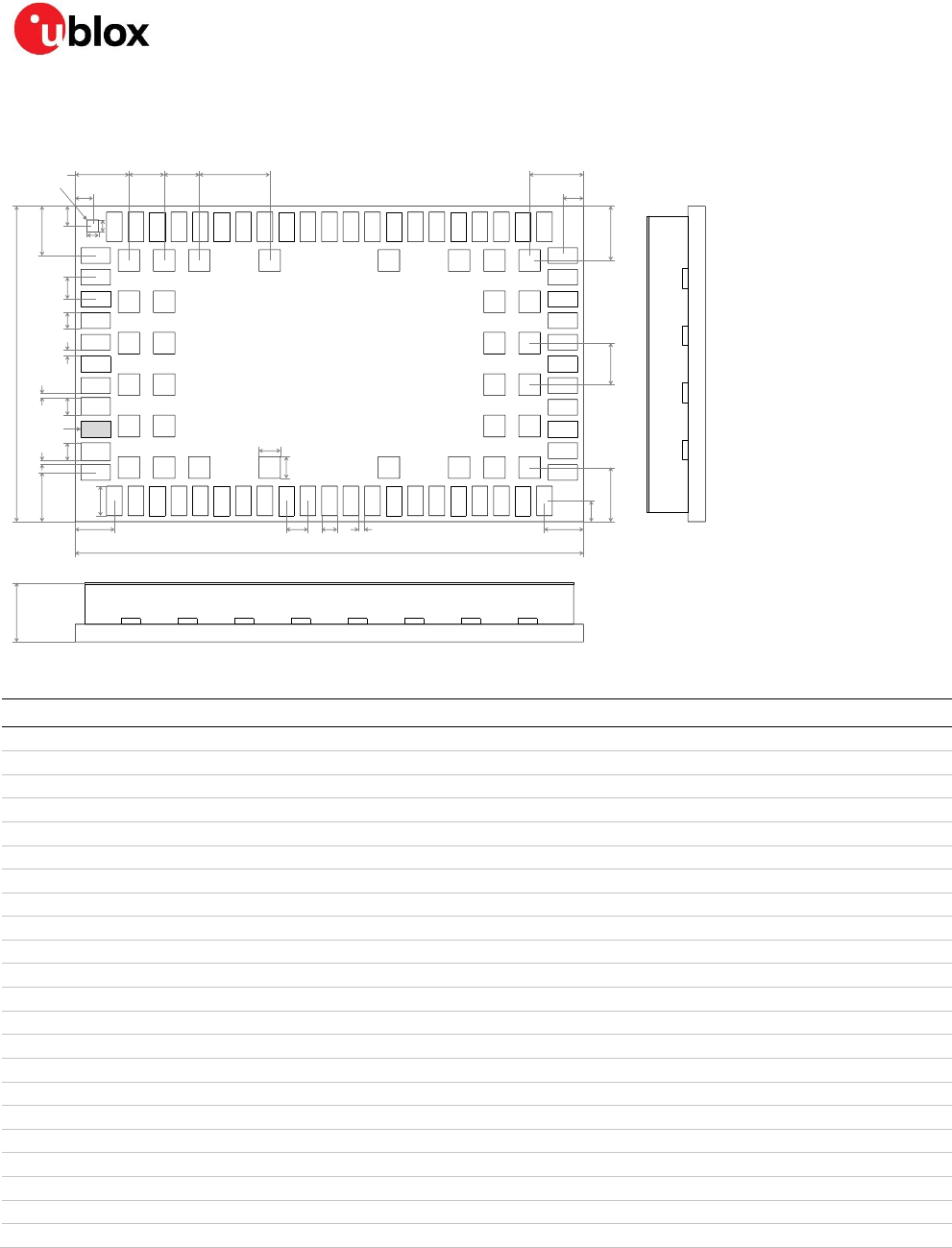
SARA-R4/N4 series - Data Sheet
UBX-16024152 - R11 Mechanical specifications Page 29 of 41
5 Mechanical specifications
C
R
R
P
Q
KM1 M1 M2
E
G
H1
J1
H2
J2
J2 H2
E
ANT pin
B
Pin 1
Indicator
K
GH1 J1
A
D D
O
O
L
N
L
I
F
F
Figure 3: SARA-R4/N4 series dimensions (bottom and side views)
Parameter
Description
Typical
Tolerance
A
Module Height [mm]
26.0
(1023.6 mil)
+0.20/-0.20
(+7.9/-7.9 mil)
B
Module Width [mm]
16.0
(629.9 mil)
+0.20/-0.20
(+7.9/-7.9 mil)
C
Module Thickness [mm]
2.53
(99.5 mil)
+0.25/-0.15
(+9.8/-5.9 mil)
D
Horizontal Edge to Lateral Pin Pitch [mm]
2.0
(78.7 mil)
+0.20/-0.20
(+7.9/-7.9 mil)
E
Vertical Edge to Lateral Pin Pitch [mm]
2.5
(98.4 mil)
+0.20/-0.20
(+7.9/-7.9 mil)
F
Edge to Lateral Pin Pitch [mm]
1.05
(41.3 mil)
+0.20/-0.20
(+7.9/-7.9 mil)
G
Lateral Pin to Pin Pitch [mm]
1.1
(43.3 mil)
+0.02/-0.02
(+0.8/-0.8 mil)
H1
Lateral Pin Height [mm]
0.8
(31.5 mil)
+0.02/-0.02
(+0.8/-0.8 mil)
H2
Lateral Pin close to ANT Height [mm]
0.9
(35.4 mil)
+0.02/-0.02
(+0.8/-0.8 mil)
I
Lateral Pin Width [mm]
1.5
(59.1 mil)
+0.02/-0.02
(+0.8/-0.8 mil)
J1
Lateral Pin to Pin Distance [mm]
0.3
(11.8 mil)
+0.02/-0.02
(+0.8/-0.8 mil)
J2
Lateral Pin to Pin close to ANT Distance [mm]
0.2
(7.9 mil)
+0.02/-0.02
(+0.8/-0.8 mil)
K
Horizontal Edge to Central Pin Pitch [mm]
2.75
(108.3 mil)
+0.20/-0.20
(+7.9/-7.9 mil)
L
Vertical Edge to Central Pin Pitch [mm]
2.75
(108.3 mil)
+0.20/-0.20
(+7.9/-7.9 mil)
M1
Central Pin to Pin Horizontal Pitch [mm]
1.8
(70.9 mil)
+0.02/-0.02
(+0.8/-0.8 mil)
M2
Central Pin to Pin Horizontal Pitch [mm]
3.6
(141.7 mil)
+0.02/-0.02
(+0.8/-0.8 mil)
N
Central Pin to Pin Vertical Pitch [mm]
2.1
(82.7 mil)
+0.02/-0.02
(+0.8/-0.8 mil)
O
Central Pin Height and Width [mm]
1.1
(43.3 mil)
+0.02/-0.02
(+0.8/-0.8 mil)
P
Horizontal Edge to Pin 1 Indicator Pitch [mm]
0.9
(35.4 mil)
+0.20/-0.20
(+7.9/-7.9 mil)
Q
Vertical Edge to Pin 1 Indicator Pitch [mm]
1.0
(39.4 mil)
+0.20/-0.20
(+7.9/-7.9 mil)
R
Pin 1 Indicator Height and Width [mm]
0.6
(23.6 mil)
+0.02/-0.02
(+0.8/-0.8 mil)
Weight
Module Weight [g]
< 3
Table 25: SARA-R4/N4 series dimensions
☞ The module height tolerance +/–0.20 mm may be exceeded close to the corners of the PCB due
to the cutting process: in the worst cases, the height could be +0.40 mm longer than the typical
value.
☞ For information regarding Footprint and Paste Mask recommended for the application board
integrating the cellular module, see the SARA-R4/N4 series System Integration Manual [2].
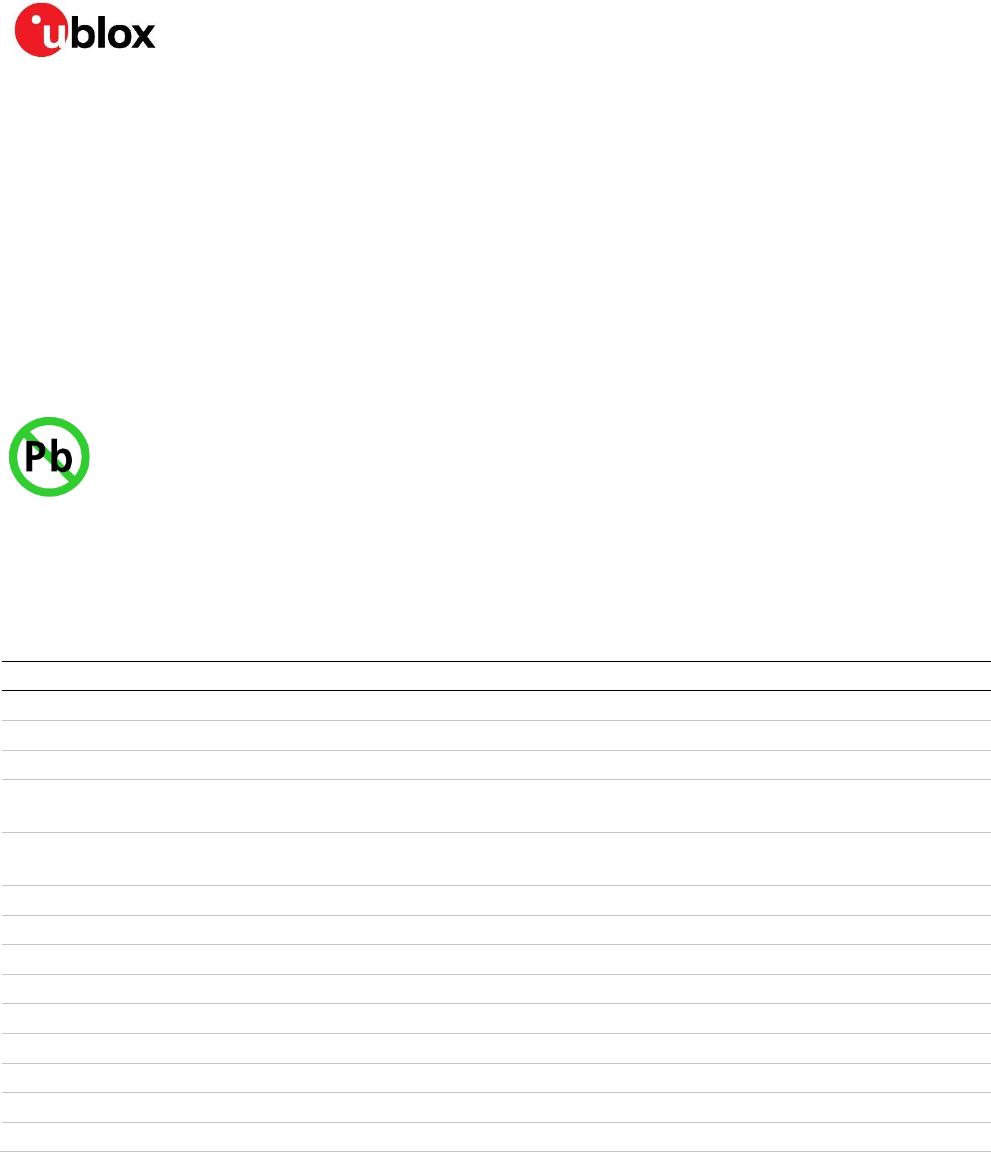
SARA-R4/N4 series - Data Sheet
UBX-16024152 - R11 Qualification and approvals Page 30 of 41
6 Qualification and approvals
6.1 Reliability tests
Tests for product family qualifications according to ISO 16750 “Road v–hicles - Environmental
conditions and testing for electrical and electronic equipment“, and appropriate standards.
6.1.1 Approvals
Products marked with this lead-free symbol on the product label comply w“th
the "Directive 2002/95/EC of the European Parliament and the Council on the
Restriction of Use of certain Hazardous Substances in Electrical and Electronic
E”uipment" (RoHS).
SARA-R4/N4 series modules are RoHS compliant.
No natural rubbers, hygroscopic materials, or materials containing asbestos
are employed.
Table 27 summarizes the main approvals for SARA-R4/N4 series modules.
Certification
SARA-R404M-00B
SARA-R410M-01B
SARA-R410M-02B
SARA-R412M-02B
SARA-N410-02B
GCF
•
PTCRB
•
•
•
•
CE Europe
•
•
FCC US
FCC ID
•
XPY2AGQN1NNN
•
XPY2AGQN4NNN
•
XPY2AGQN4NNN
•
•
ISED Canada
ISED ID
•
8595A-2AGQN4NNN
•
8595A-2AGQN4NNN
•
•
IFT Mexico
•
•
RCM Australia
•
NCC Taiwan
•
Verizon
•
•
AT&T
•
•
•
T-Mobile
•
•
Bell
•
Telus
•
Telstra
•
Table 26: SARA-R4/N4 series main certification approvals summary
☞ For guidelines and notices about compliance with certification approvals requirements
integrating the SARA-R4/N4 series modules in the end-device, see the SARA-R4/N4 series
System Integration Manual [2].
☞ For the complete list of approvals and for specific details on all country, conformance and
network operators’ certifications, including related certificates of compliancy, please contact
the u-blox office or sales representative nearest you.
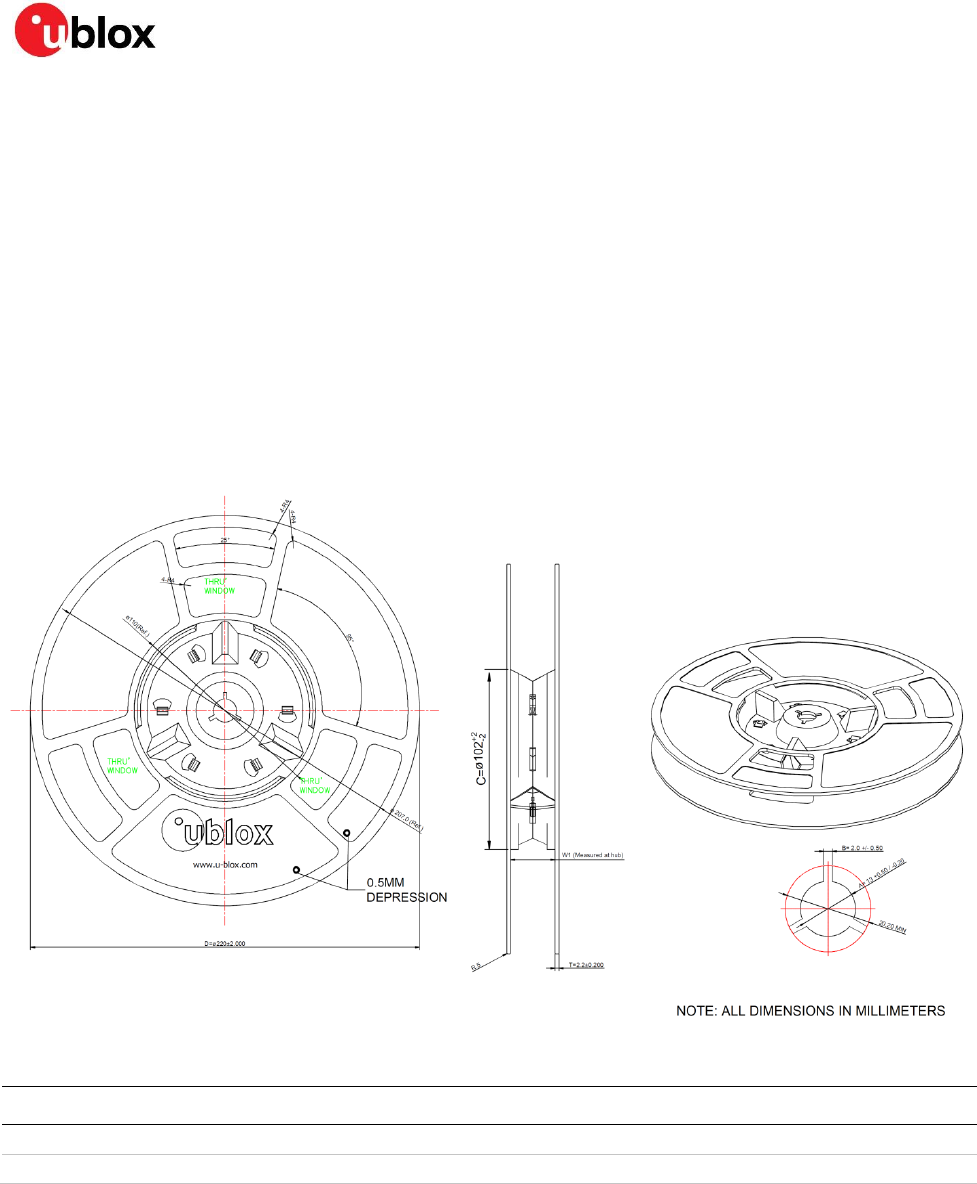
SARA-R4/N4 series - Data Sheet
UBX-16024152 - R11 Product handling & soldering Page 31 of 41
7 Product handling & soldering
7.1 Packaging
SARA-R4/N4 series modules are delivered as hermetically sealed, reeled tapes to enable efficient
production, production lot set-up and tear-down. For more information about packaging, see the
u-blox Package Information User Guide [3].
7.1.1 Reels
SARA-R4/N4 series modules are deliverable in quantities of 250 pieces on a reel. The modules are
delivered using reel type B2 described in Figure 4 and in the u-blox Package Information Guide [3].
Figure 4: SARA-R4/N4 series modules reel
Parameter
Specification
Reel Type
B2
Delivery Quantity
250
Table 27: Reel information for SARA-R4/N4 series modules
Quantities of less than 250 pieces are also available. Contact u-blox for more information.
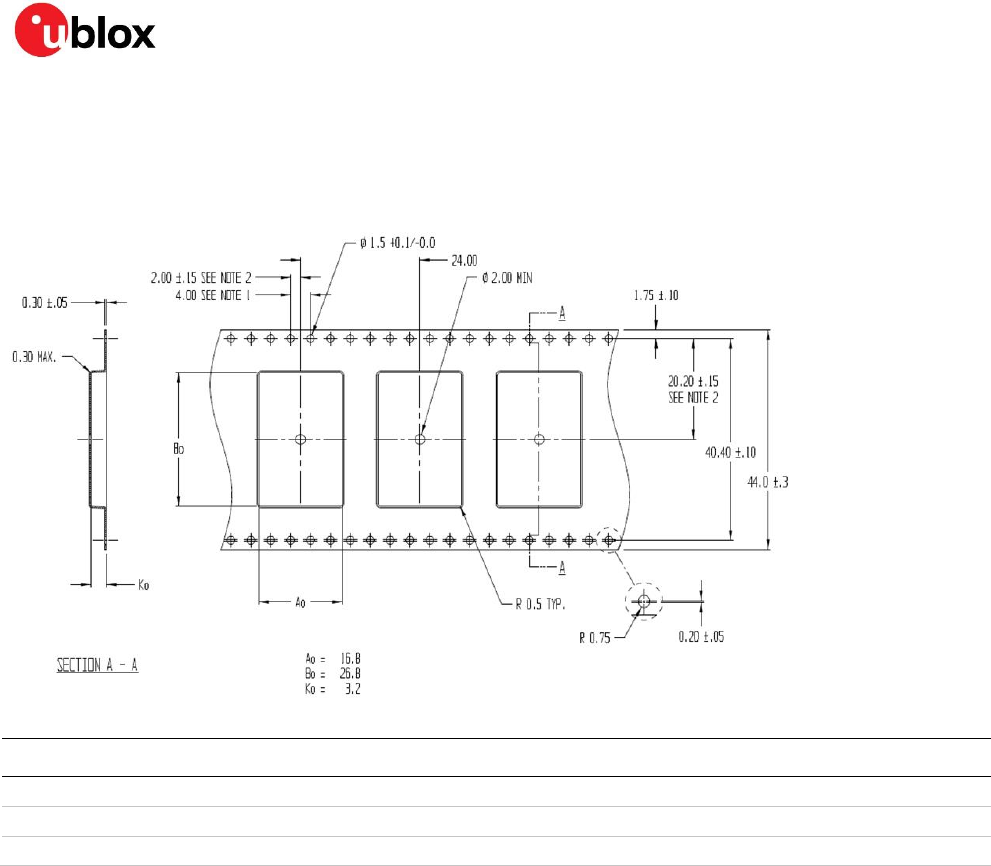
SARA-R4/N4 series - Data Sheet
UBX-16024152 - R11 Product handling & soldering Page 32 of 41
7.1.2 Tapes
Figure 5 and Table 28 specify the dimensions of the tape used for the delivery of SARA-R4/N4 series
modules.
Figure 5: SARA-R4/N4 series modules tape
Parameter
Typical value
Tolerance
Unit
A0
16.8
0.2
mm
B0
26.8
0.2
mm
K0
3.2
0.2
mm
Table 28: SARA-R4/N4 series tape dimensions (mm)
☞ Note 1: 10 sprocket hole pitch cumulative tolerance ± 0.2 mm.
☞ Note 2: pocket position relative to sprocket hole is measured as true position of pocket, not
pocket hole.
☞ Note 3: A0 and B0 are calculated on a plane at a distance “R” above the bottom of the pocket.

SARA-R4/N4 series - Data Sheet
UBX-16024152 - R11 Product handling & soldering Page 33 of 41
7.2 Moisture Sensitivity Levels
⚠ SARA-R4/N4 series modules are Moisture Sensitive Devices (MSD) in accordance to the
IPC/JEDEC specification.
The Moisture Sensitivity Level (MSL) relates to the packaging and handling precautions required.
SARA-R4/N4 series modules are rated at MSL level 4. For more information regarding moisture
sensitivity levels, labeling, storage and drying, see the u-blox Package Information Guide [3].
☞ For the MSL standard, see IPC/JEDEC J-STD-020 (can be downloaded from www.jedec.org).
7.3 Reflow soldering
Reflow profiles are to be selected according to u-blox recommendations (see the SARA-R4/N4 series
System Integration Manual [2]).
⚠ Failure to observe these recommendations can result in severe damage to the device!
7.4 ESD precautions
⚠ SARA-R4/N4 series modules contain highly sensitive electronic circuitry and are Electrostatic
Sensitive Devices (ESD). Handling SARA-R4/N4 series modules without proper ESD protection
may destroy or damage them permanently.
SARA-R4/N4 series modules are Electrostatic Sensitive Devices (ESD) and require special ESD
precautions typically applied to ESD sensitive components.
Table 7 details the maximum ESD ratings of the SARA-R4/N4 series modules.
Proper ESD handling and packaging procedures must be applied throughout the processing,
handling and operation of any application that incorporates the SARA-R4/N4 series module.
ESD precautions should be implemented on the application board where the module is mounted, as
described in the SARA-R4/N4 series System Integration Manual [2].
⚠ Failure to observe these recommendations can result in severe damage to the device!
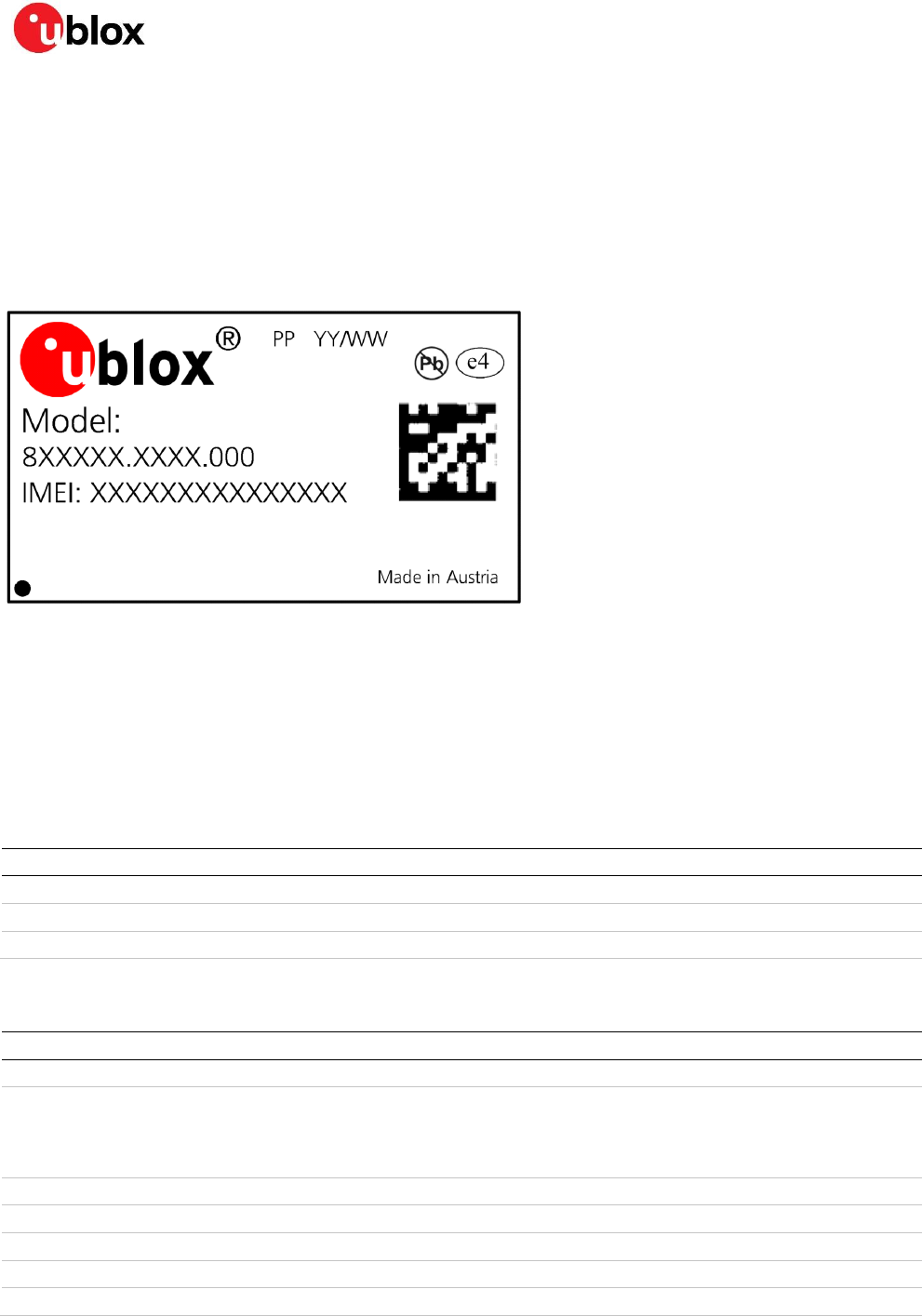
SARA-R4/N4 series - Data Sheet
UBX-16024152 - R11 Labeling and ordering information Page 34 of 41
8 Labeling and ordering information
8.1 Product labeling
The labels of SARA-R4/N4 series modules include important product information as described in
this section. Figure 6 illustrates the label of all the SARA-R4/N4 series modules, and includes: u-blox
logo, production lot, Pb-free marking, product type number, IMEI number, certification information,
and production country.
SARA-xxxxx
xxB-xx
XXX: XXXXXXXXXXXX
XXX: XXXXXXXXXXXX
Figure 6: SARA-R4/N4 series module label
8.2 Explanation of codes
Three different product code formats are used. The Product Name is used in documentation such as
this data sheet and identifies all the u-blox products, independent of packaging and quality grade.
The Ordering Code includes options and quality, while the Type Number includes the hardware and
firmware versions. Table 29 details these 3 different formats:
Format
Structure
Product Name
PPPP-TGVV(L)
Ordering Code
PPPP-TGVV(L)-MMQ
Type Number
PPPP-TGVV(L)-MMQ-XX
Table 29: Product code formats
Table 30 explains the parts of the product code.
Code
Meaning
Example
PPPP
Form factor
SARA
TG
Platform (Technology and Generation)
Dominant technology: G: GSM; U: HSUPA; C: CDMA 1xRTT; N: NB-IoT (LTE Cat NB1);
R: LTE low data rate (Cat 1 and Cat M1); L: LTE high data rate (Cat 3 and above)
Generation: 1…9
R4
VV
Variant function set based on the same platform: 00…99
04
(L)
LTE category: 6,4,3,1,M …
M
MM
Major product version: 00…99
00
Q
Product grade: B = professional, A = automotive
B
XX
Minor product version (not relevant for certification)
Default value is 00
Table 30: Part identification code
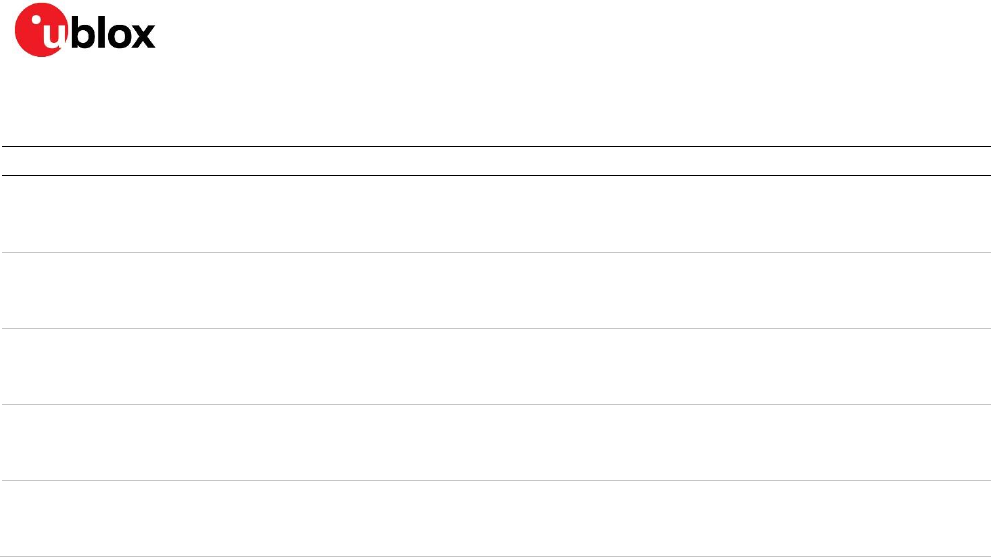
SARA-R4/N4 series - Data Sheet
UBX-16024152 - R11 Labeling and ordering information Page 35 of 41
8.3 Ordering information
Ordering No.
Product
SARA-R404M-00B
LTE Cat M1 module
Designed for operation in LTE band 13
26.0 x 16.0 mm, 250 pieces/reel
SARA-R410M-01B
LTE Cat M1 module
Designed for operation in LTE bands 2, 4, 5, 12
26.0 x 16.0 mm, 250 pieces/reel
SARA-R410M-02B
LTE Cat M1 / NB1 module
Designed for operation in LTE bands 2, 3, 4, 5, 8, 12, 13, 20, 28
26.0 x 16.0 mm, 250 pieces/reel
SARA-R412M-02B
LTE Cat M1 / NB1 and 2G module
Designed for operation in LTE bands 2, 3, 4, 5, 8, 12, 13, 20 and 2G bands 850, 900, 1800, 1900
26.0 x 16.0 mm, 250 pieces/reel
SARA-N410-02B
LTE Cat NB1 module
Designed for operation in LTE bands 2, 4, 5, 12, 13
26.0 x 16.0 mm, 250 pieces/reel
Table 31: Product ordering codes
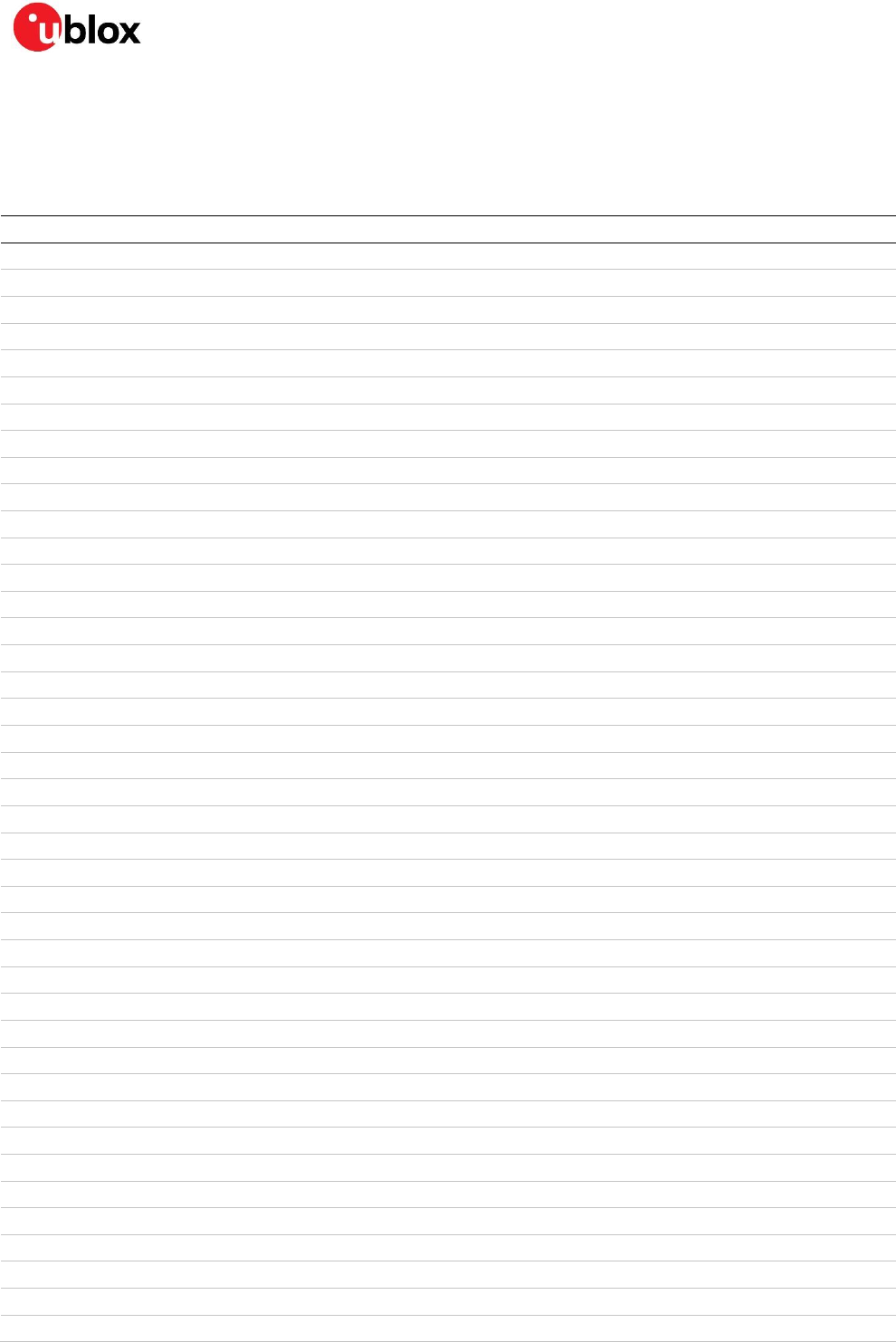
SARA-R4/N4 series - Data Sheet
UBX-16024152 - R11 Labeling and ordering information Page 36 of 41
Appendix
A Glossary
Abbreviation
Definition
2G
2nd Generation Cellular Technology (GSM, GPRS, EGPRS)
3G
3rd Generation Cellular Technology (UMTS, HSDPA, HSUPA)
3GPP
3rd Generation Partnership Project
8PSK
8-Phase Shift Keying modulation
ADC
Analog to Digital Converter
AT
AT Command Interpreter Software Subsystem, or attention
BB
Baseband
BER
Bit Error Rate
Cat
Category
CBS
Cell Broadcast Service
CCC
China Compulsory Certificate
CDMA
Code-Division Multiple Access
CE
European Conformity
CLK
Clock
CMOS
Complementary Metal-Oxide-Semiconductor
CS
Chip Select
CTS
Clear To Send
DC
Direct Current
DCD
Data Carrier Detect
DCS
Digital Cellular System
DDC
Display Data Channel
DL
Down Link (Reception)
DRX
Discontinuous Reception
DSR
Data Set Ready
DTE
Data Terminal Equipment
DTR
Data Terminal Ready
DUN
Dial-Up Networking
EDGE
Enhanced Data rates for GSM Evolution (EGPRS)
EDRX
Extended Discontinuous Reception
EGPRS
Enhanced General Packet Radio Service (EDGE)
ERS
External Reset Signal
ESD
Electrostatic Discharge
E-UTRA
Evolved Universal Terrestrial Radio Access
FCC
Federal Communications Commission United States
FDD
Frequency Division Duplex
FOAT
Firmware (update) Over AT commands
FOTA
Firmware (update) Over-The-Air
FTP
File Transfer Protocol
FW
Firmware
GCF
Global Certification Forum
GDI
Generic Digital Interface
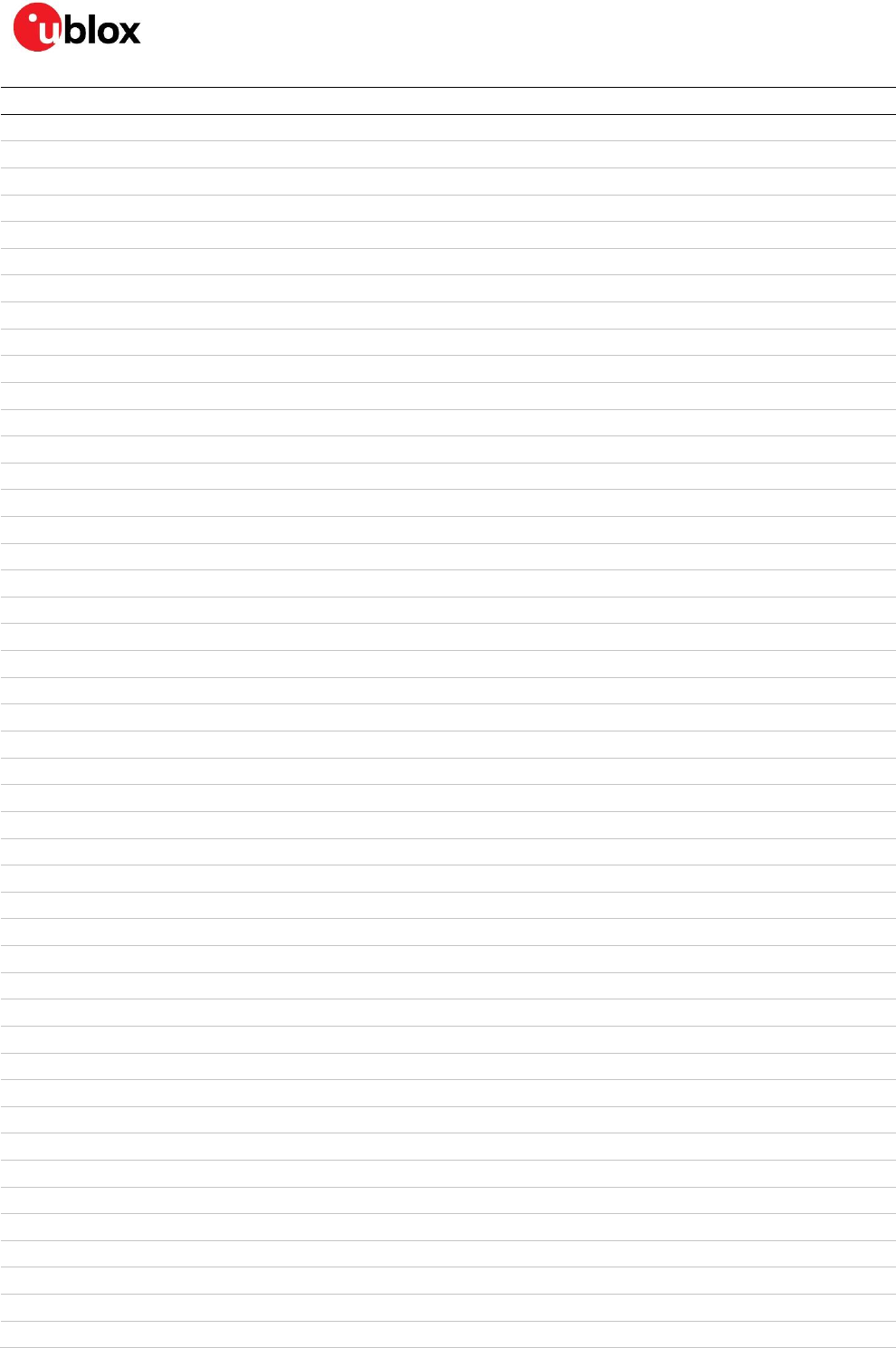
SARA-R4/N4 series - Data Sheet
UBX-16024152 - R11 Labeling and ordering information Page 37 of 41
Abbreviation
Definition
GMSK
Gaussian Minimum-Shift Keying modulation
GND
Ground
GNSS
Global Navigation Satellite System
GPIO
General Purpose Input/Output
GPRS
General Packet Radio Services
GSM
Global System for Mobile communications
HDLC
High-level Data Link Control
HSDPA
High Speed Downlink Packet Access
HSUPA
High Speed Uplink Packet Access
HTTP
HyperText Transfer Protocol
HW
Hardware
IEC
International Electrotechnical Commission
IFT
Federal Telecommunications Institute Mexico
I2C
Inter-Integrated Circuit
I2S
Inter-IC Sound
I/O
Input/Output
IMEI
International Mobile Equipment Identity
IP
Internet Protocol
ISED
Innovation, Science and Economic Development Canada
ISO
International Organization for Standardization
ITU
International Telecommunications Union
LGA
Land Grid Array
LPWA
Low Power Wide Area
LTE
Long-Term Evolution
LWM2M
Open Mobile Alliance Lightweight Machine-to-Machine protocol
M2M
Machine to Machine
MISO
Multiple Input Single Output
MOSI
Master Output Slave Input
MQTT
Message Queuing Telemetry Transport
MSD
Moisture Sensitive Device
MSL
Moisture Sensitivity Level
MUX
Multiplexer
N/A
Not Applicable
NCC
National Communications Commission Taiwan
PA
Power Amplifier
PCB
Printed Circuit Board
PCN
Product Change Notification / Sample Delivery Note / Information Note
PMU
Power Management Unit
POS
Power On Signal
PPS
Protocol and Parameter Selection
PSM
Power Saving Mode
PTCRB
PCS Type Certification Review Board
QPSK
Quadrature Phase Shift Keying modulation
RAM
Random Access Memory
RAT
Radio Access Technology
RF
Radio Frequency
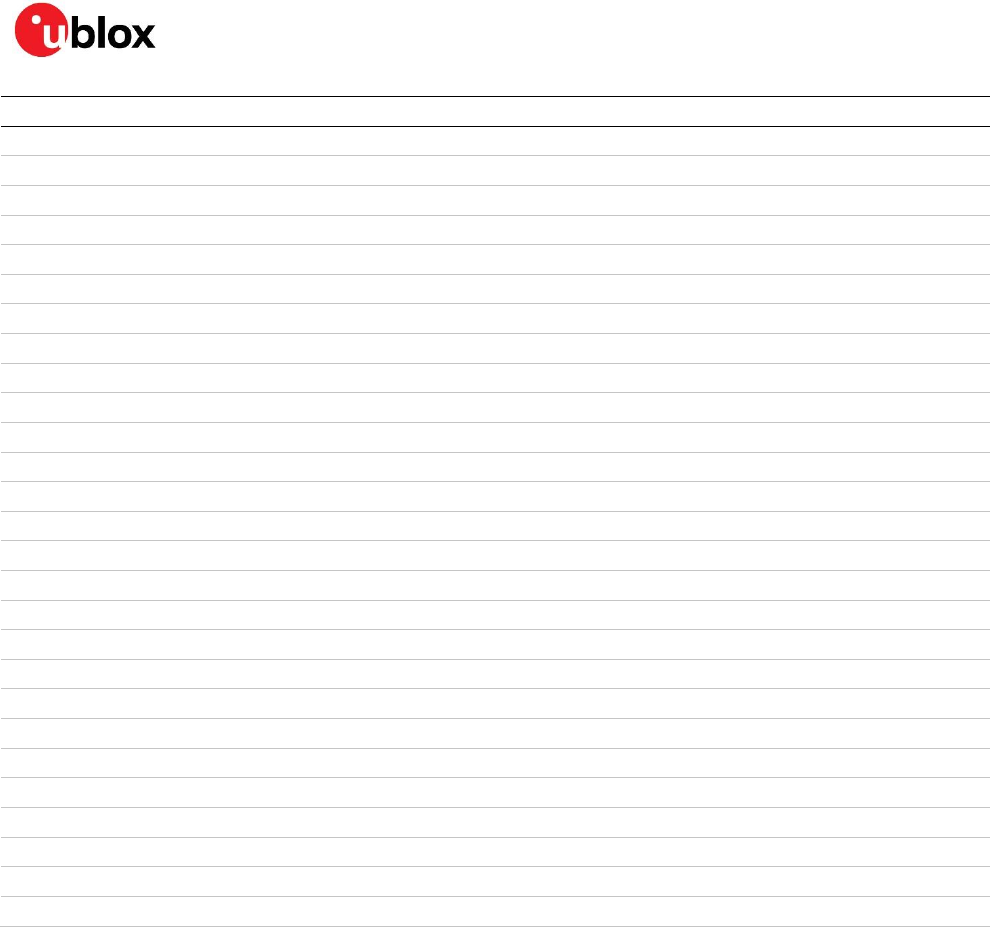
SARA-R4/N4 series - Data Sheet
UBX-16024152 - R11 Labeling and ordering information Page 38 of 41
Abbreviation
Definition
RI
Ring Indicator
RIL
Radio Interface Layer
RTS
Request To Send
SCL
Serial Clock
SDA
Serial Data
SDIO
Secure Digital Input Output
SIM
Subscriber Identity Module
SMS
Short Message Service
SPI
Serial Peripheral Interface
SRRC
State Radio Regulation Committee China
SSL
Secure Socket Layer
TA
Timing Advance
TCP
Transmission Control Protocol
TDD
Time Division Duplex
TLS
Transport Layer Security
TS
Technical Specification
TXD
Transmit Data
UART
Universal Asynchronous Receiver/Transmitter
UBX
u-blox proprietary messaging protocol
UDP
User Datagram Protocol
UE
User Equipment
UL
Uplink (Transmission)
UMTS
Universal Mobile Telecommunications System
USB
Universal Serial Bus
VoLTE
Voice over LTE
VSWR
Voltage Standing Wave Ratio
WA
Word Alignment
Table 32: Explanation of the abbreviations and terms used

SARA-R4/N4 series - Data Sheet
UBX-16024152 - R11 Related documents Page 39 of 41
Related documents
[1] u-blox SARA-R4/N4 series AT Commands Manual, Doc. No. UBX-17003787
[2] u-blox SARA-R4/N4 series System Integration Manual, Doc. No. UBX-16029218
[3] u-blox Package Information User Guide, Doc. No. UBX-14001652
[4] 3GPP TS 27.007 - AT command set for User Equipment (UE)
[5] 3GPP TS 27.005 - Use of Data Terminal Equipment - Data Circuit terminating Equipment
(DTE - DCE) interface for Short Message Service (SMS) and Cell Broadcast Service (CBS)
[6] 3GPP TS 27.010 - Terminal Equipment to User Equipment (TE-UE) multiplexer protocol
[7] 3GPP TS 36.521-1 - Evolved Universal Terrestrial Radio Access; User Equipment conformance
specification; Radio transmission and reception; Part 1: Conformance Testing
[8] 3GPP TS 51.010-1 - Mobile Station conformance specification; Part 1: Conformance specification
[9] ITU-T Recommendation V24, 02-2000. List of definitions for interchange circuits between Data
Terminal Equipment (DTE) and Data Connection Equipment (DCE)
[10] Universal Serial Bus Revision 2.0 specification, www.usb.org/developers/docs/usb20_docs/
[11] I2C-bus specification and user manual - Rev.5- 9 October 2012 - NXP Semiconductors,
www.nxp.com/documents/user_manual/UM10204.pdf
☞ For regular updates to u-blox documentation and to receive product change notifications,
register on our homepage (www.u-blox.com).
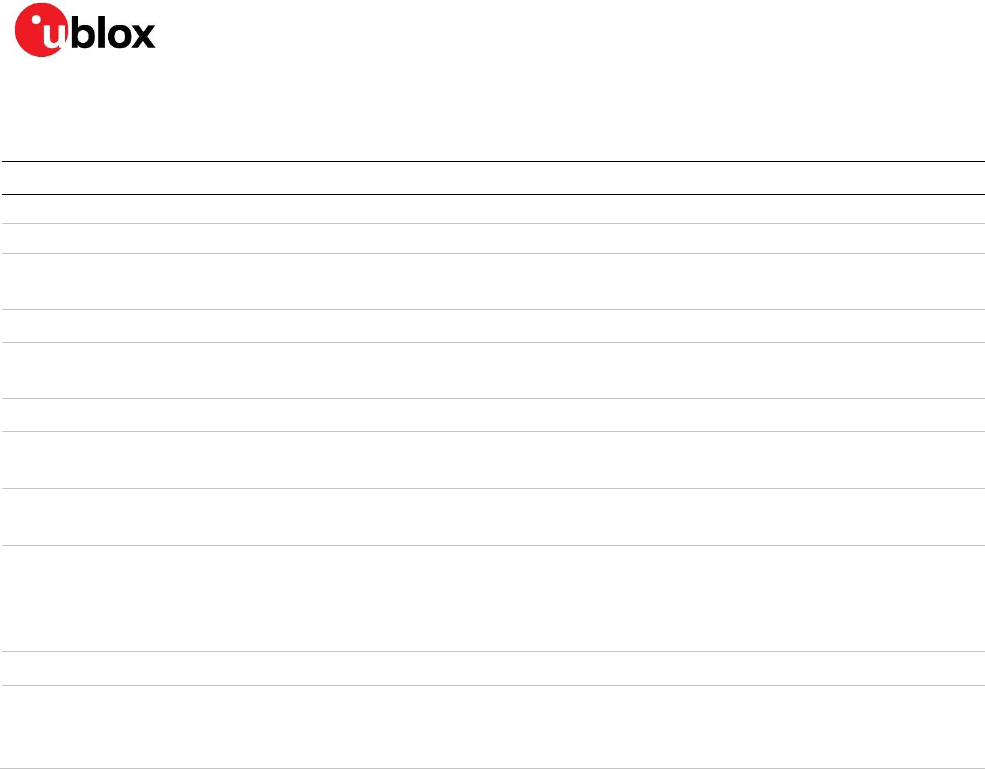
SARA-R4/N4 series - Data Sheet
UBX-16024152 - R11 Revision history Page 40 of 41
Revision history
Revision
Date
Name
Comments
R01
07-Oct-2016
sfal
Initial release
R02
02-Feb-2017
sfal
Updated supported features and electrical characteristics
R03
05-May-2017
sfal / sses
Updated supported features and electrical characteristics
Added the SARA-R410M-01B product version
R04
24-May-2017
sses
Updated supported features and electrical characteristics
R05
19-Jul-2017
sses
Updated supported features and electrical characteristics
Extended document applicability to SARA-R410M-02B product version
R06
17-Aug-2017
sses
Updated supported features for “02” product version
R07
30-Oct-2017
sses
Updated SARA-R410M-01B product status
Updated supported features for “02” product version
R08
04-Jan-2018
sses
Updated SARA-R410M-02B product status
Updated USB, GPIO and other features description
R09
26-Feb-2018
sses
Updated SARA-R410M-02B product status
Extended document applicability to SARA-R412M-02B product version
Added Current consumption, Rx sensitivity and Thermal figures
Updated UART MUX and Approvals info
R10
07-Mar-2018
mbab
u-blox rebranding. Updated SARA-R412M-02B modem and app version
R11
09-May-2018
sses
Updated SARA-R410M-02B product status
Extended document applicability to SARA-N410-02B product version
Updated UART and Approvals info

SARA-R4/N4 series - Data Sheet
UBX-16024152 - R11 Contact Page 41 of 41
Contact
For complete contact information, visit us at www.u-blox.com.
u-blox Offices
North, Central and South America
u-blox America, Inc.
Phone: +1 703 483 3180
E-mail: info_us@u-blox.com
Regional Office West Coast:
Phone: +1 408 573 3640
E-mail: info_us@u-blox.com
Technical Support:
Phone: +1 703 483 3185
E-mail: support@u-blox.com
Headquarters
Europe, Middle East, Africa
u-blox AG
Phone: +41 44 722 74 44
E-mail: info@u-blox.com
Support: support@u-blox.com
Asia, Australia, Pacific
u-blox Singapore Pte. Ltd.
Phone: +65 6734 3811
E-mail: info_ap@u-blox.com
Support: support_ap@u-blox.com
Regional Office Australia:
Phone: +61 2 8448 2016
E-mail: info_anz@u-blox.com
Support: support_ap@u-blox.com
Regional Office China (Beijing):
Phone: +86 10 68 133 545
E-mail: info_cn@u-blox.com
Support: support_cn@u-blox.com
Regional Office China (Chongqing):
Phone: +86 23 6815 1588
E-mail: info_cn@u-blox.com
Support: support_cn@u-blox.com
Regional Office China (Shanghai):
Phone: +86 21 6090 4832
E-mail: info_cn@u-blox.com
Support: support_cn@u-blox.com
Regional Office China (Shenzhen):
Phone: +86 755 8627 1083
E-mail: info_cn@u-blox.com
Support: support_cn@u-blox.com
Regional Office India:
Phone: +91 80 405 092 00
E-mail: info_in@u-blox.com
Support: support_in@u-blox.com
Regional Office Japan (Osaka):
Phone: +81 6 6941 3660
E-mail: info_jp@u-blox.com
Support: support_jp@u-blox.com
Regional Office Japan (Tokyo):
Phone: +81 3 5775 3850
E-mail: info_jp@u-blox.com
Support: support_jp@u-blox.com
Regional Office Korea:
Phone: +82 2 542 0861
E-mail: info_kr@u-blox.com
Support: support_kr@u-blox.com
Regional Office Taiwan:
Phone: +886 2 2657 1090
E-mail: info_tw@u-blox.com
Support: support_tw@u-blox.com